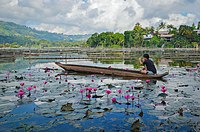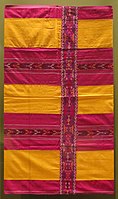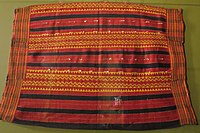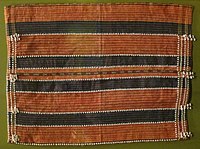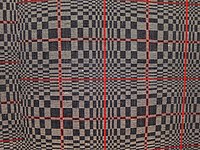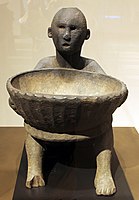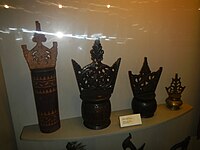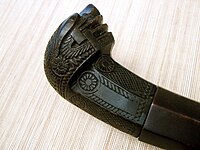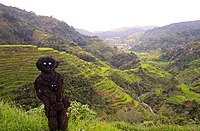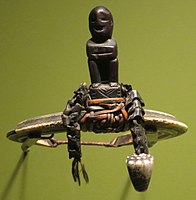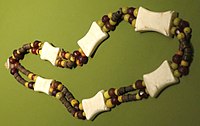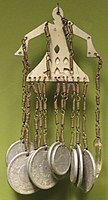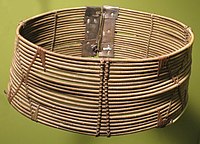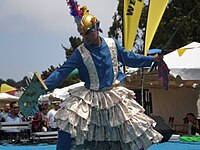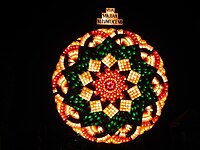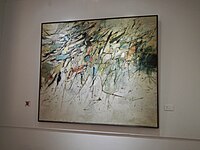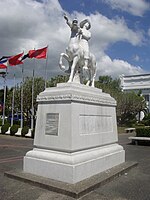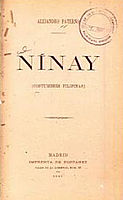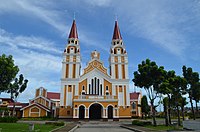Arts in the Philippines
This article contains too many pictures, charts or diagrams for its overall length. |


| Part of a series on the |
| Culture of the Philippines |
|---|
 |
| People |
| Languages |
| Traditions |
| Cuisine |
| Festivals |
| Religion |
| Art |
| Literature |
|
Arts in the Philippines refer to all the various forms of the arts that have developed and accumulated in the Philippines from the beginning of civilization in the country up to the present era. They reflect the range of artistic influences on the country's culture, including indigenous forms of the arts, and how these influences have honed the country's arts. These arts are divided into two distinct branches, namely, traditional arts[1] and non-traditional arts.[2] Each branch is further divided into various categories with subcategories.
Overview[]

The National Commission for Culture and the Arts, the official cultural agency of the government of the Philippines, has categorized Filipino arts into traditional and non-traditional. Each category are split into various arts, which in turn have sub-categories of their own.
- (A) Traditional arts[1]
- Ethnomedicine – including, but not limited to, the arts of the albularyo, the babaylan, and the manghihilot[3]
- Folk architecture – including, but not limited to, stilt houses, land houses, and aerial houses
- Maritime transport – boat houses, boat-making, and maritime traditions
- Weaving – including, but not limited to, back-strap loom weaving, and other forms of related weaving
- Carving – including, but not limited to, woodcarving and folk non-clay sculpture
- Folk performing arts – including, but not limited to, dances, plays, and dramas
- Folk (oral) literature – including, but not limited to, epics, songs, and myths
- Folk graphic and plastic arts – including, but not limited to, calligraphy, tattooing, folk writing, folk drawing, and folk painting
- Ornament – including, but not limited to, mask-making, accessory-making, ornamental metal crafts
- Textile, or fiber art – including, but not limited to, headgear weaving, basketry, fish-gear arts, and other forms of textile or fiber art
- Pottery – including, but not limited to, ceramic making, clay pot-making, and folk clay sculpture
- Other artistic expressions of traditional culture – including, but not limited to, non-ornamental metal crafts, martial arts, supernatural healing arts, medicinal arts, and constellation traditions

- (B) Non-traditional arts[2]
- Dance – including, but not limited to, dance choreography, dance direction, and dance performance
- Music – including, but not limited to, musical composition, musical direction, and musical performance
- Theater – including, but not limited to, theatrical direction, theatrical performance, theatrical production design, theatrical light and sound design, and theatrical playwriting
- Visual arts – including, but not limited to painting, non-folk sculpture, printmaking, photography, installation art, mixed media works, illustration, graphic arts, performance art, and imaging
- Literature – including, but not limited to, poetry, fiction, essay, and literary/art criticism
- Film and broadcast arts – including, but not limited to, film and broadcast direction, film and broadcast writing, film and broadcast production design, film and broadcast cinematography, film and broadcast editing, film and broadcast animation, film and broadcast performance, and film and broadcast new media
- Architecture and allied arts – including, but not limited to, non-folk architecture, interior design, landscape architecture, and urban design
- Design – including, but not limited to, industrial design, and fashion design
Traditional arts[]
The traditional arts in the Philippines encompass folk architecture, maritime transport, weaving, carving, folk performing arts, folk (oral) literature, folk graphic and plastic arts, ornament, textile, or fiber art, pottery, and other artistic expressions of traditional culture.[1] There are numerous Filipino specialists or experts on the various fields of traditional arts, with those garnering the highest distinctions declared as Gawad Manlilikha ng Bayan (GAMABA), equal to National Artist.
Ethnomedicine[]
Ethnomedicine is one of the oldest traditional arts in the Philippines. These arts possess traditions (and objects associated with it) which are performed by medical artisans and shamans, ranging from the babaylan, the manghihilot, and the albularyo. The practices, grounded on the principles of the physical elements, is both an ancient science and art known to the natives. Herbal remedies, complemented with mental, emotional, and spiritual techniques, are inherently part of many of the traditions as well. Mastery over psycho-spiritual practices are also notable in some ethnomedicine arts in the Philippines. The ethnomedicine category was recently added to the GAMABA category in 2020.[4]
Painting depicting shamanhood and ethnomedicine, including rituals

Water healing at a sacred pool in Siquijor, an island famous for its healers
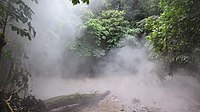
Mount Makiling is a sacred site famous for ethnomedicine & its healers
Folk architecture[]
Folk architecture in the Philippines differ significantly per ethnic group, where the structures can be made of bamboo, wood, rock, coral, rattan, grass, and other materials. These abodes can range from the hut-style bahay kubo which utilizes vernacular mediums in construction, the highland houses called bale that may have four to eight sides, depending on the ethnic association, the coral houses of Batanes which protects the natives from the harsh sandy winds of the area, the royal house torogan which is engraved with intricately-made okir motif, and the palaces of major kingdoms such as the Daru Jambangan or Palace of Flowers, which was the seat of power and residence of the head of Sulu prior to colonization. Folk architecture also includes religious buildings, generally called as spirit houses, which are shrines for the protective spirits or gods.[5][6][7] Most are house-like buildings made of native materials, and are usually open-air.[8][5] Some were originally pagoda-like, a style later continued by natives converted into Islam, but have now become extremely rare.[9] There are also buildings that have connected indigenous and Hispanic motif, forming the bahay na bato architecture, and its proto-types. Many of these bahay na bato buildings have been declared as world heritage site, as part of Vigan.[10] Folk structures include simple sacred stick stands to indigenous castles or fortresses such as the idjang, to geologically-altering works of art such as the Rice Terraces of the Philippine Cordilleras, locally called payyo.[11][12][13] Five rice terrace clusters have been declared as world heritage sites, namely Nagacadan, Hungduan, central Mayoyao, Bangaan, and Batad.[14]

Rice granaries from Ifugao, called bale

Daru Jambangan (Palace of Flowers), the royal residence of the ruler of the Tausug

Scaled-down replica of the torogan, inspired by the Kawayan Torogan, a National Cultural Treasure in Lanao del Sur
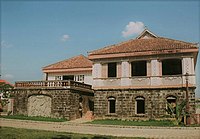
Some bahay na bato houses

Dakay house, the oldest surviving coral houses in the Philippines still used today (c. 1887)

A bahay kubo-style house in Palawan

Bahay na bato-style Yap-Sandiego House

Rice Terraces of the Philippine Cordilleras, world heritage site and a National Cultural Treasure
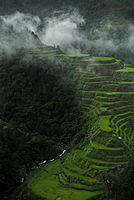
Banaue Rice Terraces
Batad Rice Terraces

Bahay na bato houses in Vigan, world heritage site and part of a National Cultural Treasure

Bahay na bato-style Lazi convent

Bahay na bato in Intramuros

Bahay na bato-style Museo de Loboc
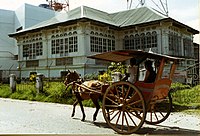
Bahay na bato-style Henson-Hizon House
Bahay na bato-style Balay Negrense

Coral house in Batanes
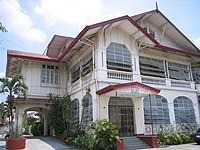
Bahay na bato-style Archdiocesan Chancery

Bahay na bato-style Bahay na Pula
Maritime transport[]
Maritime transport in the Philippines includes boat houses, boat-making, and maritime traditions. These structures, traditionally made of wood chosen by elders and craftsfolks, were used as the main vehicles of the people, connecting one island to another, where the seas and rivers became the people's roads. Although boats are believed to have been used in the archipelago for thousands of years since the arrival of humans through water, the earliest evidence of boat-making and the usage of boats in the country continues to be dated as 320 AD through the carbon-dating of the Butuan boats that are identified as remains of a gigantic balangay.[15]
Aside from the balangay, there are various styles and types of indigenous sea vehicles throughout the Philippines, such as the two-masted double-outrigger boat armadahan,[16][17] the trading ship avang,[18] the dugout canoes awang,[19] the large sailing outrigger ship balación,[20] the native and widely-available watercraft bangka,[21] the tiny canoe bangka anak-anak,[22] the salambáw-lifting basnigan,[23] the small double-outrigger sailboat bigiw,[24] the dugout canoe birau,[22] the dugout canoe buggoh,[22] the flat-floored and roofed casco,[25] the single mast and pointed chinarem,[18] the rough sea open-deck boat Chinedkeran,[18] the large double-outrigger plank boat djenging,[22] the pirate warship garay,[26] the large sailing outrigger ship guilalo,[27] the open deck boat falua,[18] the canoe junkun,[22] the small motorized boat junkung,[28] the large outrigger warship karakoa,[29] the large outrigger warship lanong,[30] the houseboat lepa,[31] the raft ontang,[22] the lake canoe owong,[32] the open-deck fishing boat panineman,[18] the double outrigger sailboat paraw,[33] the war canoe salisipan,[34] the small fishing boat tataya,[18] the motorized boat tempel, the dinghy tiririt,[35] and the outrigger boat vinta, among many others.[36] From 1565 to 1815, ships called the Manila galleons were also built by Filipino artisans.[37]

A large karakoa outrigger warship, 1711

A balangay reconstruction
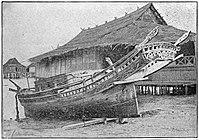
The Sama-Bajau's lepa house-boat with elaborate carvings
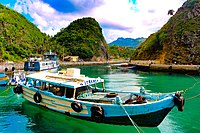
A modernized falua in Batanes

A large lanong outrigger warship, 1890

Filipino boat-builders in a Cavite shipyard (1899)

A paraw in Palawan
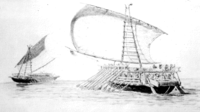
Garay warships of the Banguingui
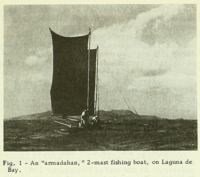
An armadahan at Laguna de Bay (1968)

War canoe salisipan, 1890

Painting of a balación, 1847

Some of the remains of the Butuan Balangay (320 AD), a National Cultural Treasure

A Manila galleon visiting Micronesia, c. 1590s
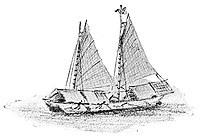
A casco, 1906
Weaving[]
Weaving is an ancient art form that continue in the Philippines today, with each ethnic group having their distinct weaving techniques.[38] The weaving arts are composed of basket weaving, back-strap loom weaving, headgear weaving, fishnet weaving, and other forms of weaving.
Cloth and mat weaving[]
Expensive textiles are made through the intricate and difficult process called back-strap looming.[39] Fibers such as Cotton, abaca, banana fiber, grass, and palm fiber are used in the Filipino weaving arts.[40] There are many types of weaved cloths in the Philippines. Pinilian is an Ilocano cotton cloth weaved using a pangablan, where weaving styles of binakul, binetwagan, or tinumballitan are inputted. Bontoc weave revolves on the concept of centeredness, a key cultural motif among the Bontoc people. In its weave, the process starts with the sides called langkit until it journeys into the pa-ikid (side panels), fatawil (warp bands), and shukyong (arrows). Afterwards, the sinamaki weaving commences, where the tinagtakho (human figure), minatmata (diamond), and tinitiko (zigzag) are incorporated. The last is center, pa-khawa, which features the kan-ay (supplementary weft). Kalinga textiles are embedded into the geometry, where motifs include continuous lozenge pattern locally called inata-ata, and mother-of-pearl platelets called pawekan, among many others. The piña fabric is considered the finest indigenous Filipino-origin textile. Those made by the Aklanon are the most prized, and are utilized in the national costumes of the country, such as barong Tagalog. Hablon is the fine textiles of the Karay-a and Hiligaynon people, which have been known from the epics of the people. The textile is usually used for Visayan patadyong and panuelo. The saputangan tapestry weave of the Yakan people is a highly skilled weaving utilizing the bunga-sama supplementary weft weave, the siniluan warp-floating pattern, the inalaman supplementary-weft technique, and the pinantupan weft band pattern. Mabal tabih of the Blaan people depicts crocodiles and curls. Weavers of the art can only be women, as the art is dedicated and taught by Furalo, goddess of weaving. Bagobo inabal utilizes abaca into creating two tube skirts, namely sinukla and bandira. Dagmay is the weaving art of the Mandaya, who use the mud-dye technique in their craft. Meranaw textile is used for the creation of the malong, among many other Maranao clothing. These crafts are imbibed with okir designs including potiok (bud), dapal or raon (leaf), pako (fern), pako rabong (growing fern) and katorai (flower). The pis syabit weave of the Tausug utilizes the free imagination of the weaver, as having no preset pattern for the weave is the cultural standard for making the high art. T'nalak is a fine textile of the Tboli crafted by the dream-weavers who are provided the designs and patterns through dreams by Fu Dalu, the deity of the abaca used in weaving.[41] The oldest known warp ikat textile in Southeast Asia is the Banton cloth of Banton, Romblon, dated at 13th to 14th century.[42]
Unlike cloth weaving, mat weaving does not utilize a loom or similar equipment and instead relies on the craftsfolk's attention in hand-weaving. The difficult art form is known throughout the Philippines, with those made in Sulu, Basilan, and Samar being the most prized. In general traditions throughout the Philippines, mat-weaving is only done in shaded and cool placed as to preserve the integrity of the mats and their fibers. An example is the banig of Basey, where the weavers usually work inside a cave. Fibers used vary from banana, grass, palm, and many others.[43]
Binakol
Itneg shaman blanket
A double ikat mat from Sulu
Rayon Malong
Silk Pis siyabit

Silk Patadyong
Banton cloth, the oldest surviving ikat textile in Southeast Asia (13th-14th century), a National Cultural Treasure

Filipino shirt made of piña (1850s)

Panel made of silk, piña, and metallic threads (1800s)
Kalinga testile used in skirt
Northern Luzon textile used in skirt
Bagobo textile used in skirt
Binakol
Basketry[]
The fine art of basket weaving in the Philippines has developed intricate designs and forms directed for specific purposes such as harvesting, rice storage, travel package, sword case, and so on. The art is believed to have arrived in the archipelago due to human migration, where those at the north were the first to learn the art form. The finest vessel basket crafts made, however, comes from the ethnic groups of Palawan, in the southwest. The Batak of Palawan has utilized the craft into high art, as well as retaining their craft's status as functional art. Intricate basketry can also be found among the Mamanwa, various Negrito groups, Mangyans, Ivatan, and many others. Materials used in basketry differ per ethnic group. Some important materials include bamboo, rattan, pandan, cotton cloth tassel, nito, beeswax, abaca, buri, bark, and dyes. In the same manner, each ethnic group has their own basketry patterns, which include closed-crossed over under weave, closed bamboo double twill weave, spaced rattan pentagon pattern, and closed tetrahedron buri, among many others. A few of the many basketry products from the Philippines include the tupil (lunch box), bukug (basket), kabil (carrying basket), uppig (lunch basket), tagga-i (rice basket), bay'ung (basket-pouch), lig-o (winnowing tray), and binga (bag).[44][45] The weaving traditions of basketry have also been influenced by modern demands.[46]
Weaved headpieces are prevalent throughout the Philippines, wherein multiple cultures utilize a variety of fibers to connect mediums forming Filipino headgears such as the Ivatan's vakul, the head-cloth of the Manobo, and the snake headpiece of the Bontoc.[47] The weaving traditions pertaining to fish traps and gears in the Philippines are expansive, of which the Ilocano people, possibly, possess the vastest array of fish gears among the archipelago's ethnic groups. Notable weaved fish traps include bubo, barekbek, and pamurakan.[48] Another weaving tradition is broom weaving, wherein the most stylized in the Philippines is possibly the talagadaw brooms made under the saked process of the Kalinga people.[49] Other weaved crafts include reed raincoats, slippers, and items used for harvesting, planting, hunting, fishing, house chores, traveling, and foraging.

Various rice baskets
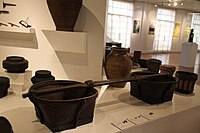
Rice transportation baskets

Filipino tobacco basket
Pasiking or basket bags

Ivatan woman wearing a vakul

T'boli women utilizing the s'laong kinibang in dance
Weaved hornbill headgear of the Ilongot
Gaddang people’s weaved headgear
Filipino weaved hats

Ilocano merchants wearing the headgear kattukong and raincoat annangá
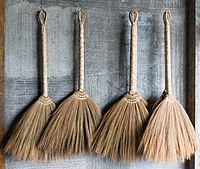
Ifugao brooms

Filipino fisherman with fish gears (c.1875)

Manila fishermen utilizing the sarambaw fishnet (c. 1800's)
Various weaved fish gears
Filipino cap
Variant of a Bontoc hat
Filipino cap with teeth, tusk, and shell
Basket crafts made by the Iraya Mangyan
Carving[]
The art of carving in the Philippines focuses on woodcarving and folk non-clay sculptures.[50][51]
Woodcarving[]
Indigenous woodcarving is one of the most notable traditional arts in the Philippines, with some crafts in various ethnic groups date back prior to Hispanic arrival with perhaps the oldest surviving today are fragments of a wooden boat dating to 320 AD.[52] Many societies utilize a variety of woods into making wood crafts such as sacred bulul figures.[53][54] These divine wooden statues, known in various groups through different generic names, abound throughout the Philippines from the northern Luzon to southern Mindanao.[55] The art of okir on wood is another fine craft attributed to various ethnic groups in Mindanao and the Sulu archipelago.[56][57] Wood crafts of specific objects, such as sword hilts, musical instruments, and other objects are also notable, where depictions of ancient mythical beings are usually carved.[58][59] There are other indigenous wood crafts and techniques in the Philippines, some of which have been utilized in Hispanic woodcarvings after colonization, such as the woodcarving styles of Paete.[60][61]
Religious Hispanic woodcarvings abounded in the Philippines with the introduction of Christianity. The techniques utilized infuse both indigenous and Hispanic styles, creating a fusion of Hispanic-Asian wood art. Paete, Laguna is among the most famous woodcarving places in the country, especially on religious Hispanic woodcarving.[60] Various epicenters of woodcarving in the Hispanic tradition are also present in many municipalities, where majority of the crafts are attributed to the life of Christ and the Virgin Mary, where Marian traditions prevail.[62]
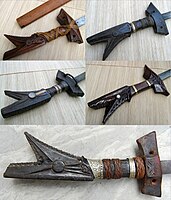
Kampilan hilts
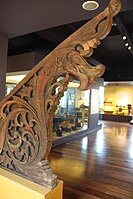
Detail of a torogan's panolong with a naga okir motif
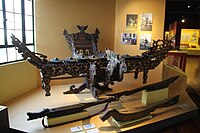
Kulintang from Mindanao

Spinning wheel

San Agustin Church door carvings (1607), part of a world heritage site and a National Cultural Treasure
Christ Child wood statue
Virgin of Sorrow
Carved saddle panel of the Yakan people, inlaid with shells
Carved bas relief at San Agustin Church, Manila
Ifugao rice spoon guarded by a wooden figure
Bulul god with pamahan cup (15th century)
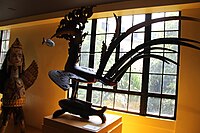
Carved sarimanok
Wooden chest with bones
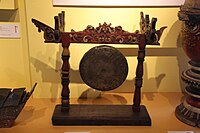
Carved holder for an agong
Maragondon Church door, part of a National Cultural Treasure
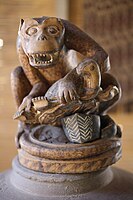
Tboli carving of a macaque and a turtle at Lake Sebu's museum

Carving depicting a Filipino farmer and a carabao
Wooden artifacts from northern Luzon
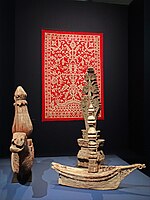
Tomb markers from the Sulu archipelago

Various crafts made with okir
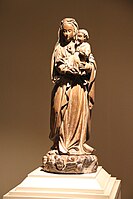
Wooden Madonna

A rare human-like depiction from Bangsamoro

Carved coconut grinder

Giant wooden drums

A number of wooden shields
Tobacco containers made of wood and bamboo
Stone, ivory, and other carvings[]
Stone carving is a prized art form in the Philippines, even prior to the arrival of Western colonizers, as seen in the stone likha and larauan or tao-tao crafts of the natives.[63] These items usually represent either an ancestor or a deity who aids the spirit of a loved one to go into the afterlife properly.[64] Ancient carved burial urns have been found in many areas, notably in the Cotabato region.[65] The Limestone tombs of Kamhantik are elaborate tombs in Quezon province, believed to initially possess rock covers signifying that they were sarcophagi. These tombs are believed to have been originally roofed, as evidenced by holes marked onto them, where beams have been placed.[66] Stone grave marks are also notable, with the people of Tawi-Tawi, and other groups using the carved marks with okir motif to aid the dead.[67] In many areas, sides of mountains are carved to form burial caves, especially in the highlands of northern Luzon. The Kabayan Mummy Burial Caves is a prime example.[68] Marble carvings are also famous, especially in its epicenter in Romblon. Majority of the marble crafts are currently meant for export, mostly Buddhist statues and related works.[69] With the arrival of Christianity, Christian stone carvings became widespread. Most of which were either parts of a church such as facades or interior statues, or statues and other crafts intended for personal altars.[70] A notable stone carving on a church is the facade of Miagao Church.[71]
Ivory carving is an art practiced in the Philippines for more than a thousand years, with the oldest known ivory artifact known is the Butuan Ivory Seal, dated 9th–12th century.[72] The religious carvings of ivory, or garing as locally known, became widespread after the direct importation of ivory into the Philippines from mainland Asia, where carvings focused on Christian icons, such as Madonna with Child, the Christ Child, and the Sorrowful Mother.[73] Many of the ivory carvings from the Philippines have gold and silver designs.[73] The ivory trade in the Philippines boomed because of the demand for ivory carvings, and continued up to the 21st century.[74] In recent years, the Philippine government has been cracking down on the illegal ivory trade. In 2013, the Philippines became the first country in the world to destroy its ivory stock, to show solidarity among like-minded nations against the ivory trade which has decimated the world's elephant and rhino populations.[75] Horns of dead carabaos have been used as a substitute to ivory in the Philippines for centuries.[76]
Stone carvings at the facade of Miagao Church, world heritage site and a National Cultural Treasure

Various ancient carved limestone burial urns

Bas relief at Panay Church (1770's)

Carved marbles from Romblon
Virgin Mary ivory head with inlaid glass eyes (18-19th century)
Visayan tenegre buffalo horn hilt
Virgin Mary, gilt and painted ivory (17th century)

Ivory carving of Christ Child with gold paint (1580-1640)
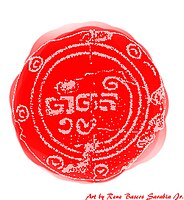
Stamp of the Butuan Ivory Seal (9th-12th century)

Our Lady of La Naval de Manila, the oldest Christian statue in the Philippines made of ivory (1593 or 1596)
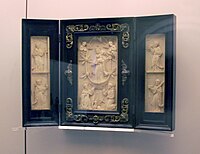
An ivory triptych (17th century)

Mother-of-pearl relief (19th century)
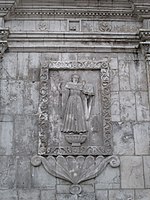
One of the carvings at the Basilica del Santo Niño
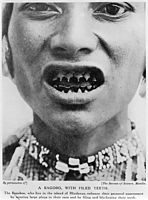
Teeth filing is present in some ethnic groups in the country

A likha portraying a god, one of only two likha that survived Spanish persecution and destruction

Limestone burial urn

Carving at Fort Santa Isabel, Taytay (1748)
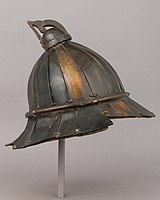
Moro helmet, exterior made of carved carabao horn (18th century)
Folk performing arts[]
Folk dances, plays, and dramas constitute most of the folk performing arts in the Philippines. Like other Southeast Asian countries, each ethnic group in the Philippines possess their own heritage on folk performing arts, however, Filipino folk performing arts also includes Spanish and American influences due to the country's historical narratives. Some dances are also related to the dances from neighboring Austronesian and other Asian countries.[77] Notable examples of folk performing arts include the banga, manmanok, ragragsakan, tarektek, uyaoy/uyauy,[78] pangalay, asik, singkil, sagayan, kapa malong malong,[79] binaylan, sugod uno, dugso, kinugsik kugsik, siring, pagdiwata, maglalatik, tinikling, subli, cariñosa, kuratsa, and pandanggo sa ilaw.[80][81][82][83] Various folk dramas and plays are known in many epics of the people. Among non-Hispanic traditions, dramas over epics like Hinilawod[84] and Ibalong[85] are known, while among Hispanic groups, the Senakulo is a notable drama.[86][87]
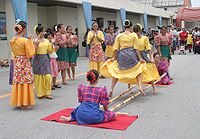
Tinikling
Pangalay
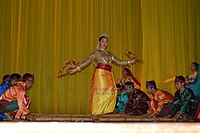
Singkil royal dance
Senakulo in Bulacan
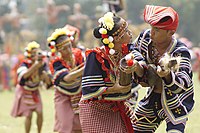
Lumad courtship dance

Bagobo musicians during the Kadayawan festival

Matigsalug kulintang ensemble
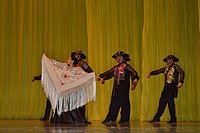
La Jota Manileña

Jota Zamboanguena Chavacano
Folk (oral) literature[]
The arts under folk (oral) literature include the epics, songs, myths, and other oral literature of numerous ethnic groups in the Philippines.
The poetic arts in the Philippines has been attributed as high in form and full of metaphor.[88] Tanaga poetry consists of 7777 syllable count, but rhymes range from dual rhyme forms to freestyle forms.[88] Awit poetry consists of 12-syllable quatrains, following the pattern of rhyming stanzas of established epics such as Pasyon,[89][90] which is chanted through the pabasa.[91] A notable awit epic-poem is the 1838 Florante at Laura.[92] Dalit poetry consists of four lines with eight syllables each.[93] Ambahan poetry consists of seven syllable lines with rhythmic end-syllables, often chanted without a determined musical pitch or musical instrument accompaniment, meant to express in an allegorical way, liberally using poetic language, certain situations or certain characteristics referred to by the one reciting the poem. It cam also be written on bamboo.[94] A notable poetry duel in the Philippines is Balagtasan, which is a debate done in verses.[95] Some notable poems include A la juventud filipina,[96] Ako'y may alaga,[97] and Kay Selya.[98]
Notable epic-poems include 17 cycled and 72,000 lined Darangen of the Maranao[99] and the 29,000-versed Hinilawod of Panay.[100] Other epic-poems from the Philippines include Biag ni Lam-Ang of the Ilocano, Ibalon of the Bicolano, Hudhud and Alim of the Ifugao, Ulalim cycle of the Kalinga, Lumalindaw of the Gaddang, Kudaman of Palawan, Agyu Cycle of the Manobo, Tulelangan of the Ilianon Manobos, Gumao of Dumalinao, Ag Tubig Nog Keboklagan, Keg Sumba Neg Sandayo of the Subanon, and Tudbulul of the Tboli people, among many others. [101] The Filipino Sign Language is used in the country to also pass on oral literature to Filipinos with hearing impairment.[102]
The oral literature have shaped the people's thinking and way of life, providing basis for values, traditions, and societal systems that aid communities in multiple facets of life. As diverse as Filipino folk literature is, many of the literary works continue to develop, with some being documented by scholars and inputted into manuscripts, tapes, video recordings, or other documentary forms.[103][104]
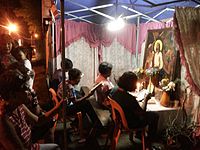
Pabasa during the Pasyon
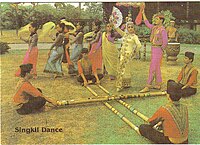
Singkil, a tradition depicting the stories from the Darangen, a world intangible heritage and a National Cultural Treasure

Bakunawa, a deity from the Visayas and Bicol, in a divination-rotation chart as explained in Signosan (1919)
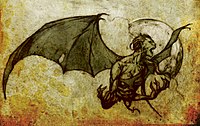
A manananggal drawing, as depicted in folk stories
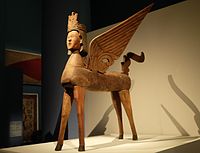
A buraq sculpture, as depicted in folk stories

Sculpture depicting Makiling, the protector-goddess of Mount Makiling
A hogang, fern-trunk statue, of a god protecting boundaries in Ifugao

Performance at the Kaamulan, depicting gods and heroes from the people's ancient religions
Folk graphic and plastic arts[]
The fields under folk graphic and plastic arts are tattooing, folk writing, and folk drawing and painting.
Folk writing (calligraphy)[]
The Philippines has numerous indigenous scripts collectively called as suyat, each of which has their own forms and styles of calligraphy. Various ethno-linguistic groups in the Philippines prior to Spanish colonization in the 16th century up to the independence era in the 21st century have used the scripts with various mediums. By the end of colonialism, only four of the suyat scripts survived and continue to be used by certain communities in everyday life. These four scripts are hanunó'o/hanunoo of the Hanuno'o Mangyan people, buhid/build of the Buhid Mangyan people, Tagbanwa script of the Tagbanwa people, and palaw'an/pala'wan (ibalnan) of the Palaw'an people. All four scripts were inscribed in the UNESCO Memory of the World Programme, under the name Philippine Paleographs (Hanunoo, Buid, Tagbanua and Pala’wan), in 1999.[105]
Due to dissent from colonialism, many artists and cultural experts have revived the usage of suyat scripts that went extinct due to Spanish persecution. These scripts being revived include the kulitan script of the Kapampangan people, the badlit script of various Visayan ethnic groups, the iniskaya script of the Eskaya people, the baybayin script of the Tagalog people, the sambali script of the Sambal people, the basahan script of the Bicolano people, the sulat pangasinan script of the Pangasinense people, and the kur-itan or kurdita script of the Ilocano people, among many others.[106][107][108][109][110] Aside from the native suyat calligraphies of the Philippines,[111][112][113] Spanish-derived calligraphy[114] and Arabic calligraphy of jawi and kirim are also used by certain communities and art groups in the Philippines.[115][116] In the last decade, calligraphy based on the suyat scripts has met popularity surges and revival.[117][118] Philippine Braille is the script used by Filipinos with visual impairment.[119]
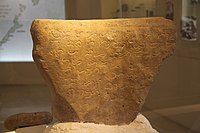
One of the Monreal Stones of Ticao written in the baybayin script

Amami, a fragment of a prayer written in kur-itan or kurdita, the first to use the krus-kudlit

Laguna Copperplate Inscription written in the kawi script, precursor to baybayin (900 CE), a National Cultural Treasure
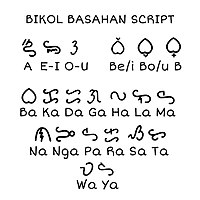
Basahan (surat bikol) script sample
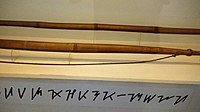
Hanunó'o calligraphy written on bamboo

Kulitan calligraphy sample
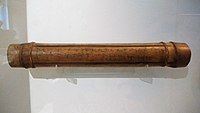
Tagbanwa calligraphy written on a musical instrument (tube zither)

Buhid script sample
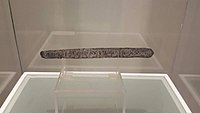
An undecipherable script written on the Butuan Silver Paleograph, a National Cultural Treasure

Jawi script, used in the Sulu archipelago
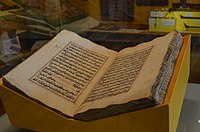
The Koran of Bayang, written in the kirim script on paper, a National Cultural Treasure; kirim is used in mainland Muslim Mindanao

Eskaya script sample
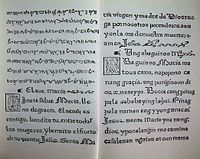
Pages of the Doctrina Christiana, in Spanish, Tagalog in Latin script and in Baybayin (1593)
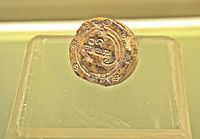
Butuan Ivory Seal, the earliest known ivory craft in the Philippines

Indigenous script in the country's passport
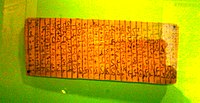
Tagbanwa calligraphy on bamboo
Folk drawing and painting[]
Folk drawings have been known for thousands of years in the archipelago. The oldest folk drawing is the rock drawings and engravings which include the petroglyphs in Angono (Rizal), which was created during the Neolithic age of the Philippines, corresponding to 6000 BC to 2000 BC. The drawings have been interpreted as religious in nature, with infant drawings made to relieve the sickness of children.[120] Another known petroglyph is in Alab (Bontoc), which is dated to be not later than 1500 BC, and represents symbols of fertility such as the pudenda. In contrast, ancient folk drawings as petrographs can be found in specific sites in the country as well. The petrographs of Peñablanca in Cagayan compose charcoal drawings. The petrographs of Singnapan in southern Palawan are also drawn with charcoal. The petrograhs in Anda (Bohol) comppose drawings made with red hematite.[121] Recently discovered petrographs in Monreal (Ticao) include drawings of monkeys, human faces, worms or snakes, plants, dragonflies, and birds.[122]
Folk paintings, like folk drawings, are works of art that usually include depictions of folk culture. Evidences suggest that the people of the archipelago have been painting and glazing their potteries for thousands of years. Pigments used in paintings range from gold, yellow, reddish purple, green, white, blue-green, to blue.[123] Statues and other creations have also been painted on by various ethnic groups, using a variety of colors. Paintings on skin with elaborate designs is also a known folk art which continue to be practiced in the Philippines, especially among the Yakan people.[124]
Tattooing was introduced by Austronesian ancestors thousands of years ago, where it developed into cultural symbols in a variety of ethnic groups.[125][126][127] Although the practice has been in place for thousands of years, its documentation was first put on paper in the 16th century, where the bravest Pintados (people of central and eastern Visayas) were the most tattooed. Similar tattooed peoples were documented among the Bicolanos of Camarines and Tagalogs of Marinduque. [128][129][130] Tattooed people in Mindanao include the Manobo, where their tattoo tradition is called pang-o-túb.[131][132] The T'boli also tattoo their skin, believing that the tattoos glow after death, guiding the soul in its journey into the afterlife.[133] But perhaps the most popular tattooed people in the Philippines are the highland peoples of Luzon collectively called the Igorot, where they are traditionally tattooed prior to colonization. Presently, only the small village of Tinglayan in Kalinga province has traditional tattoo artists crafting the batok, headed by master tattooist and Kalinga matriarch Whang-od.[134][135] In the last decade, the many traditional tattoo arts of the Philippines has experienced a revival after centuries of decline.[136] Body folk drawing adornment through scarification also exist among certain ethnic groups in the Philippines.[137]

A portion of the Angono Petroglyphs (6000-2000 BC), a National Cultural Treasure
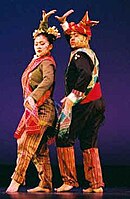
Yakan couple with traditional facial paintings called tanyak tanyak
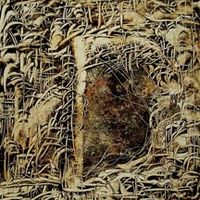
Painting made with the Waray people’s kut-kut technique, developed in Samar

Painted buraq wood sculpture from Muslims of Bangsamoro
Painted ivory statue of St. Joseph (17th century)

Pintados recorded in the Boxer Codex (c. 1590)
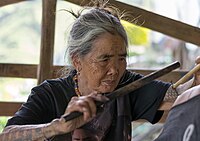
Whang-od applying a Kalinga tattoo
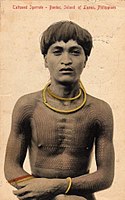
Tattooed Bontoc warrior
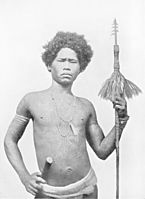
Aeta man with body scarification
Ornament[]
Ornament art includes a variety of fields, ranging from accessory-making, to ornamental metal crafts, and many others.[1]
Glass art[]
Glass art is an old art form in the Philippines, with many artifacts made of glass found in some sites such as Pinagbayanan.[138] Stained glasses have been in place in many churches in the country since Spanish occupation. Initially, European craftfolks managed the production of stained glasses in the country, but later on, Filipino craftfolks also entered the scene, notably since the 20th century.[139] An important set of stained glass creations is those from the Manila Cathedral, where the pot glass technique was used. The Marian theme is a vivid depiction throughout the glasses, with stern focus on Mary's life and saints in their Marian reverence. Major Our Lady images in the windows include the mother of Peace and Good Voyage, of Expectation, of Consolation, of Loreto, of the Pillar, of Remedies, of “La Naval,” of the Abandoned, of Carmel, of the Miraculous Medal, of the Rule, of Montserrat, of Lourdes, of Peñafrancia, of Perpetual Help, of Fatima, of Sorrows, and of Nasalambao.[140] Some glass arts in the Philippines aside from stained glasses focus on chandeliers and sculptures, among others.[141]

Jeremiah at Aringay church

San Sebastian Church window, part of a National Cultural Treasure
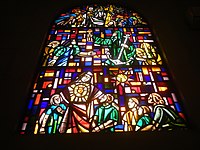
Marian depictions at the Manila Cathedral

Zadkiel at Samar church
Mary at Mexico church
Cultural Center of the Philippines chandelier
[]
Hat-making is a fine art in many communities throughout the country, with the gourd-based tabungaw of Abra and Ilocos being one of the most prized.[142] Indigenous Filipino hats were widely used in the daily lives of the people until the 20th century when they were replaced by Western-style hats. They are currently worn during certain occasions, such as festivals, rituals, or in theatre.[47][143]
The art of mask creation is both an indigenous and imported tradition, as certain communities have mask-making practices prior to colonization, while some mask-making traditions were introduced through trade from parts of Asia and the West. Today, these masks are worn mostly during festivals, Moriones Festival, and MassKara Festival.[144][145][146] A related art is puppet-making, which is notable for its products used in theater plays and festivals such as the Higantes Festival.[147] Most indigenous masks are made of wood, where these works of art are almost always rudimentary as they represent beings outside basic human comprehension. Gold masks made specifically for the dead also abound in the country, specifically in the Visayas region. However, the practice of gold mask making ceased due to Spanish colonization. Masks made of bamboo and paper used in Lucban depict the proverbial Filipino farming family. Masks of Marinduque are used in pantomimic dramatization, while masks of Bacolod depict egalitarian values, showing ancient traditions of equality among the people, regardless of economic standards. In theater, various masks are notable among epics, especially those related to the Ramayana and Mahabharata.[148]
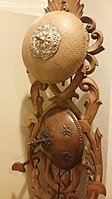
Gourd-based Salakot (bottom)

Brass helmets (top) from Bangsamoro
Bontoc wood hat

Tortoiseshell salakot with inlaid silver
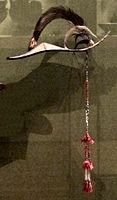
Mandaya people’s sadok
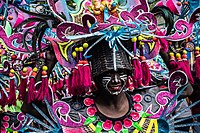
Participant with headgear during the Ati-Atihan festival
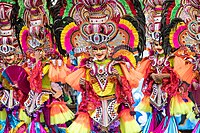
Masked participants during the MassKara Festival

Masked festival participants
Various masks used during the Kwaresma
Accessory-making[]
Accessories in the Philippines are almost always worn with their respective combination of garments, with some being used as accessories for houses, altars, and other objects. Among the more than a hundred ethnic groups in the Philippines, the most accessorized is possibly the Kalinga people.[149] The Gaddang people also exhibit a very accessorized culture.[150] The most famous accessories utilized by numerous ethnic groups in the Philippines are omege-shaped fertility objects called a lingling-o, which are used from the northern islands of Batanes to the southern islands of Palawan.[151][152] The oldest lingling-o currently known is dated at 500 BC and is made of nephrite jade.[152] Shells have traditionally been used as fine mediums for accessories in the Philippines as well.[153]
The art of gold craftsmanship is prevalent among Filipino ethnic groups, where the most known goldsmiths came from Butuan. Regalia, jewelries, ceremonial weapons, teeth ornamentation, and ritualistic and funerary objects made of high-quality gold have been excavated in many Filipino sites, attesting the archipelago's flourished gold culture between the tenth and thirteenth centuries. While certain gold craft techniques have been lost due to colonization, later techniques influenced by other cultures have also been adopted by Filipino goldsmiths.[154][155]
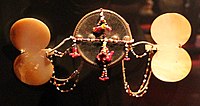
Accessory of the Gaddang people
Kankanaey arm band
A lingling-o of the Kalinga people
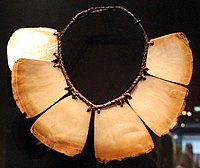
Pangalapang
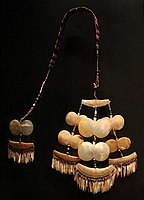
Sipatal pectoral ornament
Ilongot earring
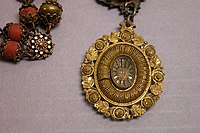
Filipino gold and coral necklace (17th-18th c.)
Gold necklace (12th-15th century)

Gold jewelries (12th-15th century)
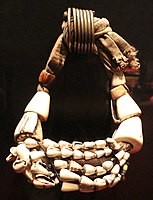
Itneg accessory
Ilongot hair ornament
Kalinga armband
Bontoc belt
Mother-of-pearl necklace
Ifugao pectoral accessory
Ilongot pendant

Necklaces made of gold, semi-precious stones, and glass (12th-15th century)
Kalinga earring
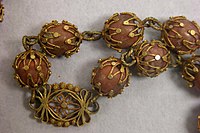
Necklace made of gold and coral (17th–19th century)
Ornamental metal crafts[]
Ornamental metal crafts are metal-based products that are specifically used to beautify something else, which may or may not be made of metal. They are prized in many communities in the Philippines, where possibly the most sought after are those made by the Maranao, specifically from Tugaya, Lanao del Sur. Metal crafts of the Moro people have been made to decorate a variety of objects, where all are imbibed with the traditional okir motif.[156] Numerous metal crafts are also utilized to design and give emphasis to religious objects such as altars, Christian statues, and clothing, among many other things. Apalit, Pampanga is one of the major centers for the craft.[157] Gold has been utilized in many ornamental crafts of the Philippines, where majority that have survived colonialism and looting are human accessories with elaborate ancient designs.[154]
Our Lady of Manaoag with metal headpiece, part of a National Cultural Treasure
Maranao kubing jaw harp with okir motif

Golden garuda ornament from Palawan

Nabua Church retablo
Santa Monica Church chandelier, part of a National Cultural Treasure
Ilongot metal bracelet
Indigenous armor from Sulu, made of metal, carabao horn, and silver
Wrought iron at Malolos Church
Northern Luzon metal belt
Textile or fiber art[]
Textile or fiber art covers many artistic expressions, including the designs of textiles dominant in Filipino clothing[1]

Filipino clothing exhibited at the Philippine Textiles Gallery
Terno (1920's)

Various Filipino textiles at the National Museum
Mestiza dress (1930's)
Pottery[]
The art of pottery, categorized into ceramic making, clay pot-making, and folk clay sculpture, has long been a part of various cultures in the Philippines, with evidence pointing to a pottery culture dating around 3,500 years ago.[158] Important pottery artifacts from the Philippines include the Manunggul Jar (890-710 BCE)[159] and the Maitum anthropomorphic pottery (5 BC-225 AD).[160] High-fired potteries were first made around 1,000 years ago, which led to what scholars describe as the 'ceramic age' in the Philippines.[123] The ceramic trade also became prevalent, where potteries and shards as far as the Arab world, possibly Egypt, and East Asia has been found in the Philippines according to the National Commission for Culture and the Arts.[123] Specific jars were also traded directly to Japan.[161] Prior to colonization, porcelain imported from foreign lands have already become popular among many communities in the archipelago as seen in the many archaeological porcelains found throughout the islands. While oral literature from Cebu have noted that porcelain were already being produced by the natives during the time of Cebu's early rulers, prior to the arrival of colonizers in the 16th century.[162] Despite this, the earliest known porcelain made by natives of the Philippines is officially dated at 1900s, as porcelain found in Filipino archaeological sites were all branded by the time of their rediscovery as "imported", which has become a major debate today. The late 19th to early 20th century led to Filipinos working as porcelain artisans in Japan to fly back into the Philippines, re-introducing the process of making the craft. All but one porcelain from the era survived World War II.[163] Notable folk clay art in the country include The Triumph of Science over Death (1890),[164] and Mother's Revenge (1894),[165] Popular potteries in the country include tapayan and palayok. The art of pottery has met media attention in recent years, as various techniques and designs are continually being crafted by Filipino artisans.[166][167]
Philippine ceramic (100-1400 CE)

Calatagan Pot with suyat calligraphy (14th-15th century)
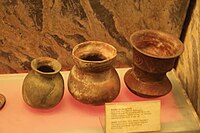
Burial pots, with the right having wave designs
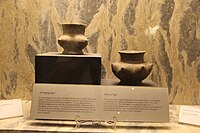
The Masuso Pots, portraying breasts in pottery

Secondary burial jars
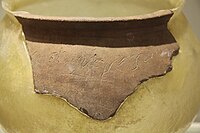
The Intramuros Pot Shard, with a script on it
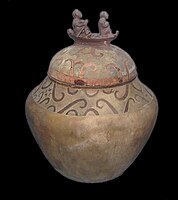
Manunggul Jar from Palawan (890–710 BC), a National Cultural Treasure
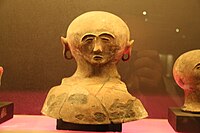
Burial jar top of one of the Maitum anthropomorphic pottery from Sarangani (5 BC-370 AD)
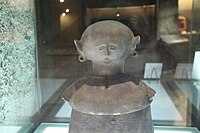
Maitum Anthropomorphic Burial Jar No. 13 (5 BC-370 AD), a National Cultural Treasure

Itneg pottery house for an anito (c. 1922)

The Mother's Revenge (1894), a National Cultural Treasure
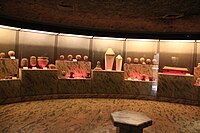
Multiple clay heads used as toppings for burial jars, each with a unique face

An ancient mini-jar and a goblet

An ancient burial jar head

Porcelain found in the Philippines
Porcelain jar found in the Philippines (11th century)

Porcelain found in Palawan (15th century)
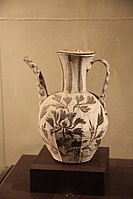
Porcelain found in the Philippines (11th-12th century)
Other artistic expressions of traditional culture[]
Various traditional arts are too distinct to be categorized into specific sections. Among these art forms include non-ornamental metal crafts, martial arts, supernatural healing arts, medicinal arts, and constellation traditions, among many others.
Non-ornamental metal crafts[]
Non-ornamental metal crafts are metal products that stand on their own. These crafts are usually already beautiful as they are, and seldom need ornamental metal crafts to further their indigenous aesthetics. Each ethnic group has their own terms for artisans specializing in metal works, with the Moro people being one of the foremost creators of quality metal works, which usually are decorated with the okir motif.[168] Metal crafts are also notable among the craftsfolk of various craft epicenters of the country, such as Baguio in the north.[169] Hispanic metal crafts are prevalent among lowlanders. These crafts usually include giant bells, where the largest in Asia is conserved at Panay Church.[170] Deity crafts made of metals, notably gold, has been found in the Philippines as well, with the Agusan image being a notable example.[154][171]
Brass gadur
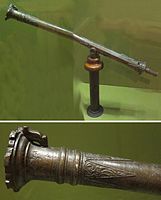
Lantaka guns
Copper betel nut box with silver inlay

Ewer from Mindanao (1800)

Inkwell Stand (19th century)

Detail of a lantaka gun

Silver ciborium
The largest church bell in Asia, housed at Panay Church, a National Cultural Treasure

Manobo jewel case
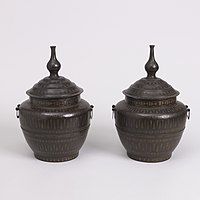
Bronze jars (19th century)
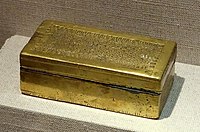
Hinged brass box (1800)
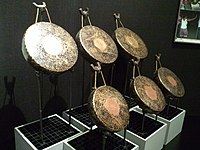
Gangsa gongs of the Kalinga people

Kulintang gongs of the Maranao people
Blade arts[]
The art of sword making is an ancient tradition in the Philippines, where Filipino bladesmiths have been creating quality swords and other bladed weapons for centuries, with a diverse array of types influenced by the sheer diversity of ethnic groups in the archipelago. Many of the swords are specifically made for ceremonial functions and agricultural functions, while certain types are used specifically for offensive and defensive warfare. The most known Filipino sword is the kampilan, a well-defined sharp blade with an aesthetically-protruding spikelet along the flat side of the tip and a pommel which depicts one of four sacred creatures, a bakunawa (dragon), a buaya (crocodile), a kalaw (hornbill), or a kakatua (cockatoo).[172] Other Filipino bladed weapons include the winged dagger balarao, the convex sword balasiong, the butterfly knife balisong, the modernized sword balisword, the slash-hack sword bangkung, the top-concave sword banyal, the leaf sword barong, the wide-tipped batangas, the machete bolo, the rice-leaf sword dahong palay, the dagger-kalis gunong, the double-edged anti-slip gayang, the machete golok, the wavy sword kalis, the claw knife karambit, the battle axe panabas, the white sword pinutí, the machete pirah, the last-resort knife gunong, the devastation sword susuwat, the sawtooth sword tagan, and the wide-tipped utak. A variety of spears (sibat), axes, darts (bagakay), and arrows (pana/busog) are also utilized by all ethnic groups in the country.[173]
Kampilan sword from Sulu
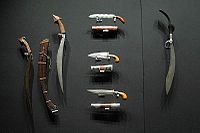
Basih weapons

Yakan ceremonial swords

Lumad swords from Mindanao and Igorot axes from Luzon
Kalis sword from Sulu

Moro swords

War, ceremonial, and fishing spears in the Philippines
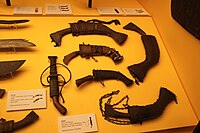
Lumad daggers in Mindanao
Swords from Luzon and Visayas
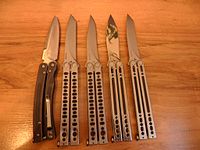
Some types of balisong
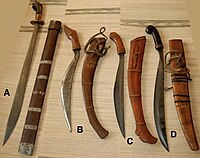
Various swords from the Visayas
Martial arts[]
Filipino martial arts vary from ethnic group to ethnic group due to the diversity of cultures within the archipelago. The most famous is Arnis (also called kali and eskrima), the national sport and martial art of the Philippines, which emphasize weapon-based fighting styles with sticks, knives, bladed weapons and various improvised weapons as well as open hand techniques. Arnis has met various cultural changes throughout history, where it was also known as estoque, estocada, and garrote during the Spanish occupation. Spanish recorderd first encountered the prevalent martial art as paccalicali-t to the Ibanags, didya/kabaroan) to the Ilocanos, sitbatan/kalirongan to Pangasinenses, sinawali ("to weave") to the Kapampangans, calis/pananandata (use of weapons) to the Tagalogs, pagaradman to the Ilonggos, and kaliradman to the Cebuanos.[174]
Unarmed martial techniques include Pangamot of the Bisaya, suntukan of the Tagalog, Rizal's sikaran of the Tagalog, dumog of the Karay-a, buno of the Igorot people, and yaw-yan. Some impact martial weapons include baston or olisi, bangkaw or tongat, dulo-dulo, and tameng. Edged martial weapons include daga/cuchillo which utilizes gunong, punyal and barung or barong, balisong, karambit which used blades similar to tiger claws, espada which utilizes kampilan, ginunting, pinuti and talibong, itak, kalis which uses poison-bladed daggers known as kris, golok, sibat, sundang, lagaraw, ginunting, and pinunting. Flexible martial weapons include latigo, buntot pagi, lubid, sarong, cadena or tanikala, tabak-toyok. Some projectile martial weapons include pana, sibat, sumpit, bagakay, tirador or pintik/saltik, kana, lantaka, and luthang.[175][176][177] There are also martial arts practiced traditionally in the Philippines and neighboring Austronesian countries as related arts such as kuntaw and silat.[178][179][180]

Kalasag, shields used in Filipino warfare

Arnis being taught in Australia
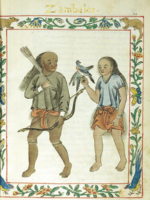
Sambal warriors specializing in archery and falconry, recorded in the Boxer Codex

A martial artist wielding an arnis or eskrima
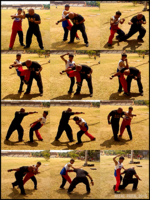
Suntukan sequence
Kuntaw utilized in dance
Statue depicting the sikaran
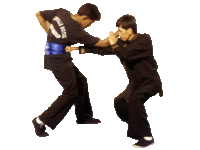
Jendo[181]
Culinary arts[]
Filipino cuisine is composed of the cuisines of more than a hundred ethnolinguistic groups found within the Philippine archipelago. The majority of mainstream Filipino dishes that compose Filipino cuisine are from the cuisines of the Bikol, Chavacano, Hiligaynon, Ilocano, Kapampangan, Maranao, Pangasinan, Cebuano (or Bisaya), Tagalog, and Waray ethnolinguistic tribes. The style of cooking and the food associated with it have evolved over many centuries from their Austronesian origins to a mixed cuisine of Indian, Chinese, Spanish, and American influences, in line with the major waves of influence that had enriched the cultures of the archipelago, as well as others adapted to indigenous ingredients and the local palate.[182] Dishes range from the very simple, like a meal of fried salted fish and rice, to the complex paellas and cocidos created for fiestas of Spanish origin. Popular dishes include: lechón[183] (whole roasted pig), longganisa (Philippine sausage), tapa (cured beef), torta (omelette), adobo (chicken or pork braised in garlic, vinegar, oil and soy sauce, or cooked until dry), kaldereta (meat in tomato sauce stew), mechado (larded beef in soy and tomato sauce), puchero (beef in bananas and tomato sauce), afritada (chicken or pork simmered in tomato sauce with vegetables), kare-kare (oxtail and vegetables cooked in peanut sauce), pinakbet (kabocha squash, eggplant, beans, okra, and tomato stew flavored with shrimp paste), crispy pata (deep-fried pig's leg), hamonado (pork sweetened in pineapple sauce), sinigang (meat or seafood in sour broth), pancit (noodles), and lumpia (fresh or fried spring rolls).[184]

A variety of Filipino food, including kare-kare, pinakbet, dinuguan, and crispy pata

Tapsilog, a common Filipino breakfast made of egg, rice, and beef or venison

Sisig, usually served in scorching metal plates
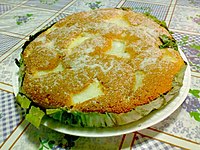
Bibingka, a popular Christmas rice cake with salted egg and grated coconut toppings

Halo-halo, a common Filipino dessert or summer snack
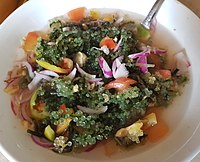
Kinilaw, a ceviche-like dish made of either seaweed, raw fish, tamilok, tofu, and others

Bagnet, crispy pork belly usually partnered with pinakbet and dinardaraan

Chicken adobo on rice

Satti grilled meat served with ta'mu rice cakes

Tapuy rice wine partnered with biko rice cake

Atchara, a type of pickled papaya used as a palate cleanser
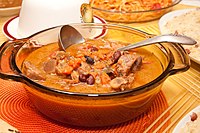
Kaldereta, a stew usually cooked using goat meat

Sinigang, a sour soup with meat and vegetables
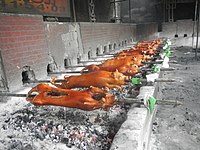
Lechon, whole roasted pig, stuffed with spices

Lumpiang ubod, a type of unfried vegetable lumpia
Other traditional arts[]
Shell crafts are prevalent throughout the Philippines due to the vast array of mollusk shells available within the archipelago. The shell industry in the country prioritizes crafts made of capiz shells, which are seen in various products ranging from windows, statues, lamps, and many others.[153] Lantern-making is also a traditional art form in the country. The art began after the introduction of Christianity, and many lanterns (locally called parol) appear in Filipino streets and in front of houses, welcoming the Christmas season, which usually begins in September and ends in January in the Philippines, creating the longest Christmas season of any country in the world. A notable festival celebrating Christmas and lanterns is the Giant Lantern Festival, which exhibits gigantic lanterns crafted by Filipino artisans.[185] The art of pyrotechnics is popular in the country during the New Year celebrations and the days before it during the Christmas season. Since 2010, the Philippines has been hosting the Philippine International Pyromusical Competition, the world's largest pyrotechnic competition, previously called the World Pyro Olympics.[186] Lacquerware is an introduced art form in the Philippines. Although prized, only a few Filipino artisans have ventured into the art form. Filipino researchers are recently studying the possibility of turning coconut oil in lacquer.[187][188][189] Paper arts are prevalent in many communities in the Philippines. Some examples of paper art include the taka papier-mâché of Laguna and the pabalat craft of Bulacan.[190] One form of leaf folding art in the country is the puni, which utilizes palm leaves to create various forms such as birds and insects.[190] Bamboo arts are widespread in the country, with various products being made of bamboo from kitchen utensils, toys, furniture, to musical instruments such as the Las Piñas Bamboo Organ, the world's oldest and only organ made of bamboo.[191] A notable bamboo art is the bulakaykay, which bamboos are intentionally bristled to create elaborate and large arches.[190] Floristry is a fine art that continues to be popular during certain occasions such as festivals, birthdays, and Undas.[192] The art of leaf speech, including its language and its deciphering, is a notable art among the Dumagat people, who use a mixture of leaves to express themselves to others and to send secret messages.[193] The art of shamanism and its related arts such as medicinal and healing arts are found in all ethnic groups throughout the country, with each group having their own unique concepts of shamanism and healing practices. Philippine shamans are regarded as sacred by their respective ethnic groups. The introduction of Abrahamic religions, by way of Islam and Christianity, downgraded many shamanitic traditions, with Spanish and American colonizers demeaning the native faiths during the colonial era. Shamans and their practices continue in certain places in the country, although conversions to Abrahamic faiths continue to interfere with their indigenous life-ways.[194] The art of constellation and cosmic reading and interpretation is a fundamental tradition among all Filipino ethnic groups, as the stars are used to interpret the world's standing for communities to conduct proper farming, fishing, festivities, and other important activities. A notable constellation with varying versions among Filipino ethnic groups include Balatik and Moroporo.[195] Another cosmic reading is the utilization of earthly monuments, such as the Gueday stone calendar of Besao, which the locals use to see the arrival of kasilapet, which signals the end of the current agricultural season and the beginning of the next cycle.[196]
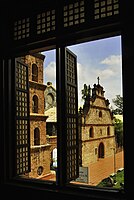
Capiz shell window
Typical shell lamp in the Philippines
A huge lantern during the Giant Lantern Festival

Traditional bamboo and paper lanterns, sometimes made with bamboo and capiz shells as well
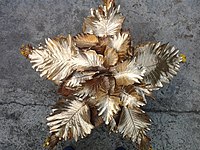
Traditional leaf lantern
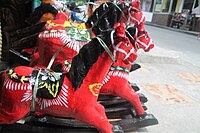
Taka, a type of papier-mâché art in Laguna
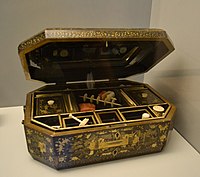
Lacquered sewing box
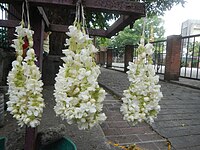
One form of sampaguita garland-making

A traditional floral arrangement for the dead

Las Piñas Bamboo Organ (1824), a National Cultural Treasure
Non-traditional arts[]
The non-traditional arts in the Philippines encompass dance, music, theater, visual arts, literature, film and broadcast arts, architecture and allied arts, and design.[2] There are numerous Filipino specialists or experts on the various fields of non-traditional arts, with those garnering the highest distinctions declared as National Artist, equal to Gawad Manlilika ng Bayan (GAMABA).
Dance[]
The art of dance under the non-traditional category covers dance choreography, dance direction, and dance performance. Philippine dance is influenced by the folk performing arts of the country, as well as its Hispanic traditions. Many styles also developed due to global influences. Dances of the Igorot dances, such as banga,[78] Moro dances, such as pangalay and singkil,[79] Lumad dances, such as kuntaw and kadal taho and lawin-lawin, Hispanic dances, such as maglalatik and subli, have been inputted into contemporary Filipino dances.[80][81][82][83] Ballet has also become a popular dance form in the Philippines since the early 20th century.[197] Pinoy hip hop music has influenced specific dances in the country, where many have adapted global standards in hip hop and break dances.[198] Many choreographers in the Philippines focus on both traditional and Westernized dances, with certain dance companies focusing on Hispanic and traditional forms of dance.[199][200]
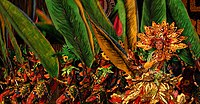
Dancers during the Sinulog Festival

Dancers performing Tboli dances in an international stage
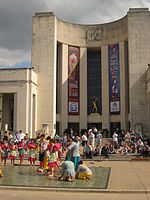
Filipinos performing Hispanic dances in an international stage
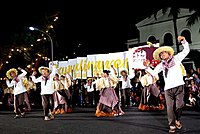
Dancers during the Pamulinawen

Performers of Moro dances in an international stage
Music[]
Musical composition, musical direction, and musical performance are the core of the art of music under the non-traditional category. The basis of Filipino music is the vast musical tangible and intangible heritage of the many ethnic groups in the archipelago, where some of which have been influenced by other Asian and Western cultures, notably Hispanic and American music. Philippine folk music includes the chanting of epic poetry, such as the Darangen and Hudhud ni Aliguyon, and singing of folk music traditions through various means such as the Harana. Some Filipino music genre include Manila sound which brought hopeful themes amidst the decaying status of the country during the martial law years,[201] Pinoy reggae which focuses on dancehall music faithful to the expressions of Jamaican reggae,[202] Pinoy rock which encompasses rock music with Filipino cultural sensibilities,[203] Pinoy pop which is one of the most popular genre in the country,[204] Tagonggo which is music traditionally played by finely-dressed male musicians,[205] Kapanirong which is a serenade genre,[206] Kulintang which is a genre of an entire ensemble of musicians utilizing a diverse array of traditional musical instruments,[207] Kundiman which is a traditional genre of Filipino love music,[208] Bisrock which is a genre of Sebwano rock music,[209] and Pinoy hip hop which is genre of hip hop adopted from American hip hop music.[210]
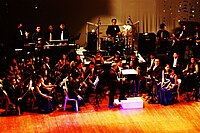
Choir music

PUP Chorale

University of the Philippines Madrigal Singers
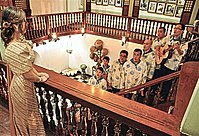
Depiction of harana
Theater[]
Theater has a long history in the Philippines. The basis of which is the folk performing arts under the traditional arts. In the non-traditional category, theatrical direction, theatrical performance, theatrical production design, theatrical light and sound design, and theatrical playwriting are the focal arts. Theater in the Philippines is Austronesian in character, which is seen in rituals, mimetic dances, and mimetic customs of the people. Plays with Spanish influences have affected Filipino theater and drama, notably the komedya, the sinakulo, the playlets, the sarswela, and the Filipino drama. Puppetry, such as carrillo, is also a notable theater art.[211] In contrast, theater with Anglo-American influence have also mixed with various art forms such as bodabil and the plays in English. Modern and original plays by Filipinos have also influenced Philippine theater and drama with the usage of representational and presentational styles drawn from contemporary modern theater and revitalized traditional forms from within or outside the country.[212][213][214]
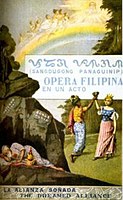
Promotion for the opera, Sangdugong Panaguinip (1902)

Tanghalang Pambansa (National Theater)
FEU's Art-deco style Auditorium

Manila Metropolitan Theater, a National Cultural Treasure
Visual arts[]
The visual arts under the non-traditional arts include painting, non-folk sculpture, printmaking, photography, installation art, mixed media works, illustration, graphic arts, performance art, and imaging.
Painting[]
Folk painting has always been part of various cultures in the Philippines.[215][216] Petroglyphs and petrographs are the earliest known folk drawings and paintings in the country, with the oldest made during the Neolithic age.[217] Human figures, frogs, lizards, along with other designs have been depicted. They may have been mostly symbolic representations and are associated with healing and sympathetic magic.[218] The influences brought by other Asian and Western cultures artistically advanced the art of paintings. In the 16th century and throughout the colonization era, paintings of religious propaganda for the spread of Catholicism became rampant. Majority of these paintings are essentially part of church structures, such as ceilings and walls. At the same time, non-religious paintings were also known.[219] Notable painting during the time include the image of Nuestra Senora de la Soledad de Porta Vaga (1692)[220] and paintings at Camarin de da Virgen (1720).[221] In the 19th century, wealthier, educated Filipinos introduced more secular Filipino art, causing art in the Philippines to deviate from religious motifs. The use of watercolour paintings increased and the subject matter of paintings began to include landscapes, Filipino inhabitants, Philippine fashion, and government officials. Portrait paintings featured the painters themselves, Filipino jewelry, and native furniture. Landscape paintings portrayed scenes of average Filipinos partaking in their daily tasks. These paintings often showcased ornately painted artists' names. These paintings were done on canvas, wood, and a variety of metals.[219] Notable watercolor paintings were done in the Tipos del País style[222] or the Letras y figuras style.[223] Notable oil paintings of the 19th century include Basi Revolt paintings (1807), Sacred Art of the Parish Church of Santiago Apostol (1852), Spoliarium (1884), La Bulaqueña (1895), and The Parisian Life (1892).[221] In the American occupation, a notable Filipino painting was The Progress of Medicine in the Philippines (1953).[221] After World War II, painting were heavily influenced by the effects of war. Common themes included battle scenes, destruction, and the suffering of the Filipino people.[224] Nationalistic themes in painting continued amidst the war's effects. Prime examples include International Rice Research Institute (1962) and the Manila Mural (1968)[221] Paintings of the 20th-21st century have showcased the native cultures of the Philippines, as part of the spread of nationalism.[225] Notable paintings during the era include Chickens (1968)[226] and Sarimanok series (late 20th century).[227] Some works have also criticized the lingering colonial viewpoints in the country, such as discrimination against darker-skinned people and the negative effects of colonialism. Notable artistic pieces of this topic are Filipina: A racial identity crisis (1990's),[228][229] and The Brown Man's Burden (2003).[230] Numerous works of art have been made specifically as protest art against state authoritarian rule, human rights violations, and fascism.[231][232][233]

Nuestra Senora de la Soledad de Porta Vaga, a National Cultural Treasure

Mujer filipina (1895)

Tampuhan (1895)
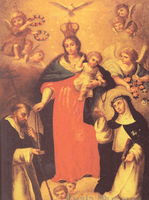
Nuestra Señora del Santisimo Rosario (1820-30's)

Manila canal (19th cent.)

La Bulaqueña (1895), a National Cultural Treasure

La vendedora de lanzones (1877)
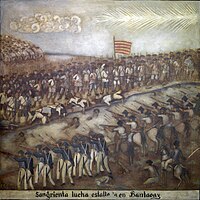
Basi Revolt (1807), a National Cultural Treasure
One of the Sacred Art of the Parish Church of Santiago Apostol paintings (1852), a National Cultural Treasure
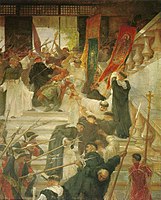
The Assassination of Governor Bustamante and His Son (1904), a National Cultural Treasure

The Parisian Life (Interior d'un Cafi) (1892), a National Cultural Treasure

One of the Camarín de la Virgen paintings (1720–1725), a National Cultural Treasure
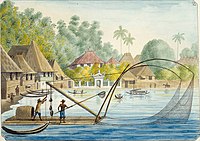
Painting utilizing the Letras y figuras technique (1847)
The Progress of Medicine in the Philippines (1953), a National Cultural Treasure
Abstract painting at the National Museum (1964)

Filipina (1869-1937)

The Death of Cleopatra (1881)

El Kundiman (1932)
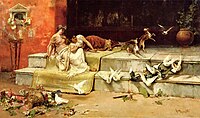
Las Damas Romanas (1882)

Entrance of the Camarin de la Virgen (1720–1725), a National Cultural Treasure

Dolores Paterno (1870)
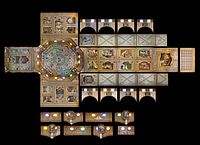
Balilihan Church ceiling
Our Lady of the Rosary retablo
Sculpture[]
Non-folk sculpture in the Philippines is a major art form, with many artists and students focusing on the subject.[234] Notable non-folk sculptures include Oblation, which reflects selfless dedication and service to the nation,[citation needed] Rizal Monument, depicting Filipino martyr and scholar Jose Rizal,[235] Tandang Sora National Shrine, depicting the revolutionary mother of the Katipunan Melchora Aquino,[236] Mactan Shrine, which depicts the classical-era hero Lapulapu who vanquished the colonizers during his lifetime,[237] People Power Monument, which celebrates the power and activism of the people over its government,[238] Filipina Comfort Women, which immortalizes the suffering of and judicial need for Filipina comfort women during World War II,[239] and the Bonifacio Monument, depicting the revolutionary hero Andres Bonifacio.[240][241]
Mary and Child

Rizal Monument (1913), a National Cultural Treasure

Bonifacio Monument (1933), a National Cultural Treasure
Commonwealth statue
Tomb and statue of Gregorio del Pilar
Sculpture from the National Museum
Other visual arts[]
Printmaking began in the Philippines after the religious orders at the time, namely Dominicans, Franciscans and Jesuits, started printing prayer books and inexpensive prints of religious images, such as the Virgin Mary, Jesus Christ, or the saints, known as estampas or estampitas, which were used to spread Roman Catholicism and to further colonize the islands. Maps were also printed through the art form, which includes the 1734 Velarde map. Printmaking has since diversified in the country, which has included woodblock printing and other forms.[242] Photography started in the country in the 1840s, upon the introduction of the photographic equipment. Photos were used during the colonial era as mediums for news, tourism, instruments for anthropology and documentation, and as a means for the Spanish and Americans to assert their perceived social status onto the natives to support colonial propaganda.[243] This later changed upon Philippine independence, where photography became widely used by the people for personal documentation and commercial usage.[244] Other forms of visual arts in the Philippines are installation art, mixed media works, illustration, graphic arts, performance art, and imaging.

Religious print used for colonialism in the Philippines, 1896

An original copy of the printed Velarde map, 1734
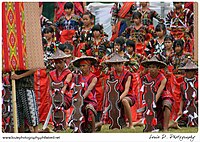
Photo of Tboli people in regalia during the Tnalak festival, 2009
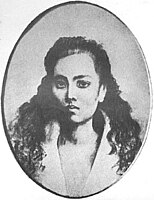
Leonor Rivera crayon sketch (19th century)
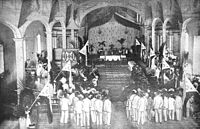
Malolos Congress photo (1898)

Pre-1863 lithograph photo of Malolos Cathedral

Third frame of the Filipino comic, The Monkey and The Turtle (1886)
Literature[]
Poetry, fiction, essay, and literary/art criticism are the focal arts of literature under the non-traditional arts, which are usually based on or influenced by the traditional art of folk (oral) literature of the natives, which focuses greatly on works of art from epics, ethnic mythologies, and related stories and traditions. In some cultures, calligraphy on various mediums were utilized to create literary works. An example is the ambahan of the Hanunoo Mangyan.[245] Literature under the colonial regime focused greatly on Spanish-language works under Spanish occupation, then adjusting to the English-language under American occupation. From 1593 to 1800, majority of literary arts made in the Philippines were Spanish-language religious works, with a noble book being Doctrina Christiana (1593)[246] and a Tagalog rendition of the Pasyon (1704).[247] There are also works in the colonial eras that are written in native languages, mostly religious and government scripts for the propagation of colonialism.[243] Nevertheless, Filipino literary works without colonial propaganda were made by local authors as well. At the same time, certain folk (oral) literature were inputted into manuscripts by Filipino writers such as the 17th century manuscript of the ancient Ilocano epic Biag ni Lam-ang.[248] In 1869, the epic Florante at Laura was published, inputting fiction writing with Asian and European themes.[249][250] In 1878[251] or 1894,[252] the first modern play in any Philippine language, Ang Babai nga Huaran, was written in Hiligaynon. By the 19th century, the formative years of Spanish literature in the country moved forward into what became the nationalist stage of 1883-1903. During this era, the first novel written by a Filipino, Nínay, was published. Works of literary art critical of colonial rulers became known as well, such as the 1887 Noli Me Tángere and the 1891 El filibusterismo.[253] The first novel in Sebwano, Maming, was published in 1900.[254] The so-called golden age of Spanish-language literature in the Philippines began in 1903 to 1966, despite American occupation. During this era, works in native languages and in English started to boom as well. The go-to book of the working class, Banaag at Sikat, was published in 1906, where the literary work dives into the concepts of socialism, capitalism, and the united laborers.[255] The first Filipino book written in English, The Child of Sorrow, was published in 1921. The early writing in English are characterized by melodrama, unreal language, and unsubtle emphasis on local color.[256] The literary content later imbibed themes that express the search for Filipino identity, reconciling the centuries-old Spanish and American influence to the Philippines' archipelagic Asian heritage.[257] From 1966 to 1967, fragments of Sa mga Kuko ng Liwanag were published, and later in 1986, the fragments were inputted into a novel.[258] During the martial law era, prominent literary works tackling the evident human rights violations of those in power were published, such as Dekada '70 (1983)[259] and Luha ng Buwaya (1983).[260][261] Filipino literature in the 21st century dives into historical narratives in modernity, global outlooks, and concepts of equality and nationalism. Major works include Smaller and Smaller Circles (2002),[262] Ladlad (2007),[263] Ilustrado (2008),[264] and Insurrecto (2018).[265]
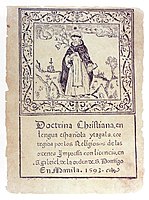
Doctrina Christiana, 1593
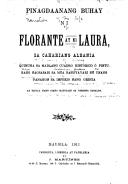
Florante at Laura, originally published in 1869
Nínay, 1885

Noli Me Tángere, 1887

El filibusterismo, 1891
Film and broadcast arts[]
Film and broadcast arts focuses on the arts of direction, writing, production design, cinematography, editing, animation, performance, and new media.
The origin of the cinematic arts in the Philippines officially began in 1897, upon the introduction of moving pictures into Manila. Filipinos aided foreign filmmakers in the Philippines for a time, until in 1919, when filmmaker José Nepomuceno made the first ever Filipino film, Dalagang Bukid (Country Maiden).[266] By the 1930s, the formative years of Filipino cinema began as interest in film genre as art began among the common folk. Theatre became an important influence to the boom of cinema in the Philippines. The 1940s created films that would point towards the reality of the people, due to the occupation years during World War II. More artistic and mature films sprang a decade later under the banner of quality films, as perceived at the time.[267][268] The 1960s showed an era of commercialism, fan movies, soft porn films, action flicks, and western spin-offs, until the golden age of cinema met the turbulent years from the 1970s to 1980's due to the dictatorship. The films under the period were overseen by the government, with various filmmakers being arrested. A notable film made during the period is Himala, which tackles the concept of religious fanaticism. The period after martial rule dealt with more serious topics, with independent films being made by many filmmakers. The 1990s saw the emergence of films related to Western films, along with the continued popularity of films focusing on the realities of poverty. Among the direst films at the time include Manila in the Claws of Light, The Flor Contemplacion Story, Oro, Plata, Mata, and Sa Pusod ng Dagat.[268] Cinema in 21st century Philippines has met a revival of popular watchings, with films being produced by various fronts. Films regarding human equality, concepts of poverty, self-love, and historical narratives have met popular success.[269] Key films during the era include The Blossoming of Maximo Oliveros,[270] Caregiver,[271] Kinatay,[272] Thy Womb,[273] That Thing Called Tadhana,[274] The Woman Who Left,[275] and the film version of the book Smaller and Smaller Circles.[276]

A cinema inside a Filipino mall

A postcard for the film, Zamboanga (1936)
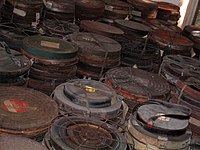
Various decaying old Filipino films. Restoration of some films have been undertaken by the ABS-CBN Film Restoration Project
Eden, a former cinema conserved as part of the Malolos Historic Town Center
Architecture and allied arts[]
Architecture under the category of non-traditional arts focus on non-folk architecture and its allied arts such as interior design, landscape architecture, and urban design.
Non-folk architecture[]
The basis of Filipino non-folk architecture is the folk architecture of various ethnic groups within the Philippines. The diversity in vernacular architecture range from the bahay kubo, bahay na bato, torogan, idjang, payyo, and ethnic shrines and mosques.[277] Upon the arrival of the Spanish in the 16th century, various Western architectures were introduced such as Baroque, which was used to establish the Manila Cathedral and Boljoon Church. However, due to the geologic nature of the islands, the Baroque architecture was later turned into a unique style now known as Earthquake Baroque, which was used into the building of Binondo Church, Daraga Church, and the world heritage sites of Paoay Church, Miagao Church, San Agustin Church, and Santa Maria Church.[71][278][279] Throughout the colonial eras, from Spanish to American rule, various architecture styles were introduced. A notable Gothic Revival building is the San Sebastian Church, the only all-steel church in Asia. Beaux-Arts became popular among the wealthy classes. A notable example is the Lopez Heritage House.[277] Art Deco continues to be a popular architecture in certain Filipino communities, with the city of Sariaya considered as the country's Art Deco capital.[280] Italian and Italian-Spanish architecture can be seen on certain buildings such as Fort Santiago and The Ruins. Stick-style is notable among some wood buildings such as the Silliman Hall. Neoclassical is perhaps the most vividly depicted in the Philippines, as many government buildings follow the architecture. Examples include the Baguio Cathedral, Manila Central Post Office, and the National Museum of Fine Arts. Even after independence, architecture continued to evolve, with the usage of Brutalist architecture during the martial law era. After the restoration of democracy, a revival of indigenous architecture into neo-vernacular architecture occurred in the late 20th century and the 21st century. These buildings and structures have become iconic bases for Filipino nationalism and ethnic representation. Modern-style architecture is presently a popular style in the Philippines, with some examples include the Saint Andrew the Apostle Church and the Manila Hotel.[277] In the present era, demolitions of culturally important buildings and structures have happened, despite the enactment of laws disallowing such acts. Many cultural workers and architects have made advances to stop the demolitions of certain buildings and structures.[281]
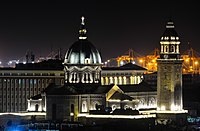
Baroque Manila Cathedral (c. 1571, rebuilt 1954)
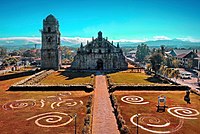
Earthquake baroque Paoay Church (c. 1694), world heritage site and a National Cultural Treasure

Gothic revival San Sebastian Church (c. 1891), a National Cultural Treasure

Baroque Boljoon Church (c. 1783), a National Cultural Treasure
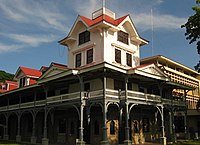
Stick-style Silliman Hall (c. 1909)

Beaux-Arts Lopez Heritage House (c. 1928)

Neo-vernacular Baguio Museum (c. 1975)
Fort Santiago (c. 1593), a National Cultural Treasure
Art Deco Natalio Enriquez Ancestral House (c. 1931)
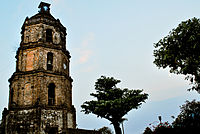
Earthquake baroque Belfry of Santa Maria Church (c. 1810), world heritage site and a National Cultural Treasure

Neo-vernacular Cotabato City Hall (20th century)
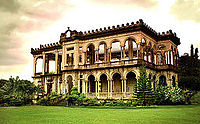
Italian-style The Ruins (mansion) (c. 1990's)
Neoclassical, Beaux-Arts Jones Bridge (c. 1919, rebuilt 1946)
Baroque Tayum Church (1803), a National Cultural Treasure
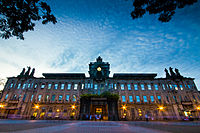
Renaissance revival University of Santo Tomas Main Building (1927), a National Cultural Treasure

Malagonlong Bridge (1841), a National Cultural Treasure
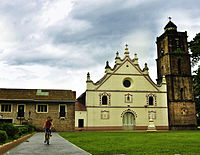
Baroque Dupax Church (1776), a National Cultural Treasure

Baroque Tumauini Church (1805), a National Cultural Treasure
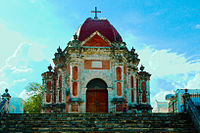
Baroque San Joaquin Campo Santo (1892), a National Cultural Treasure
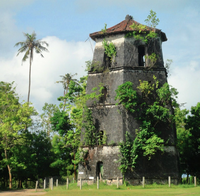
Panglao Watchtower, a National Cultural Treasure
Fortress-style Capul Church (1781), a National Cultural Treasure

Barn-style Jasaan Church (1887), a National Cultural Treasure
Moorish-style Sulu Provincial Capitol building

Neo-vernacular Coconut Palace (1978)
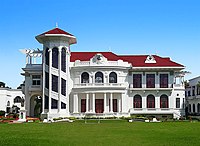
Spanish-American Lizares Mansion (1937)

Truss-style San Juanico Bridge (1973)
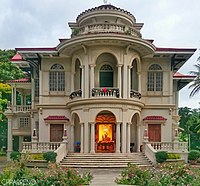
Neoclassical-Art Deco Molo Mansion (1920's)

Neoclassical Manila Central Post Office (1928)
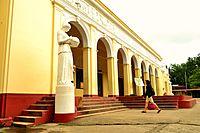
Gabaldon-style Negros Occidental High School (1927)
Loon Church (1864)
Palo Cathedral (1596)

Above-ground walls of the Nagcarlan Underground Cemetery

Manila City Hall Clock-tower

International and Art deco style FEU campus

Buddhist Seng Guan Temple (20th century)

Neo-gothic feminist Molo Church
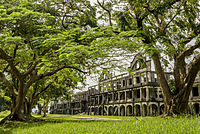
Barracks at Corregidor
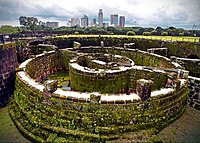
Bastion-style Baluarte de San Diego (1587)

Baroque Tuguegarao Cathedral (1768)

Churrigueresque Baroque Daraga Church (1773)

Baroque-neoclassical Lazi Church (1857)
Dapitan Church (1871)

Mexican Baroque Quiapo Church bell tower (1984)

Barasoain Church
Architecturally allied arts[]
The allied arts of architecture include interior design, landscape architecture, and urban design. Interior design in the Philippines has been influenced by indigenous Filipino interiors and cultures, Hispanic styles, American styles, Japanese styles, modern design, avant-garde, tropical design, neo-vernacular, international style, and sustainable design. As interior spaces are expressions of culture, values, and aspirations, they have been heavily researched on by Filipino scholars.[282] Common interior design styles in the country for decades have been Tropical, Filipino, Japanese, Mediterranean, Chinese, Moorish, Victorian, and Baroque, while Avant Garde Industrial, Tech and Trendy, Metallic Glam, Rustic Luxe, Eclectic Elegance, Organic Opulence, Design Deconstructed, and Funk Art have recently become popular.[283] Landscape architecture in the Philippines initially followed the client's opulence, however, in recent years, the emphasis has been on the ecosystem and sustainability.[284] Urban planning is a key economic and cultural issue in the Philippines, notably due to the high population of the country, marked with problems on infrastructures such as transportation. Many urban planners have initiated proposals for the uplifting of urban areas, especially in congested and flood-prone Metro Manila.[285][286]
Interior of Betis Church, a National Cultural Treasure
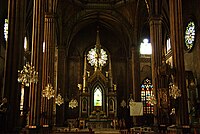
Interior of San Sebastian Church, a National Cultural Treasure

Interior of San Agustin Church, a National Cultural Treasure
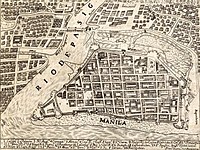
Urban design for Intramuros, 1734

Balay Negrense interior
Pelaez Ancestral House interior
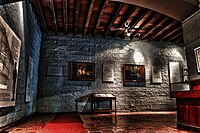
Calamba Rizal Shrine interior

Marcela Agoncillo House interior
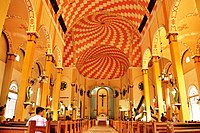
Dapitan Church interior

Wright Park in front of the Baguio Mansion

Dapitan's Mindanao relief map (c. 1892), a National Cultural Treasure
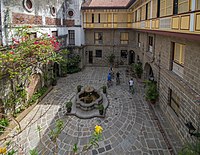
Casa Manila courtyard
Paco Park, a National Cultural Treasure

Center of Burnham Park (Baguio)

Plaza Moriones, Intramuros
Design[]
The art of design is present in all forms of art, whether traditional or non-traditional, however, the design arts under the non-traditional arts usually emphasize industrial design and fashion design.
Industrial design[]
Industrial design, or the art where design precedes manufacture for products intended for mass production,[287][288] has been a key factor in improving the Philippine economy. Many artistic creations in the country are made through research and development, which interplay with aesthetics that allures customers. Packaging of food and other products, as well as the main aesthetics of certain products such as gadgets, are prime examples of industrial design, along with the aesthetics of mass-produced vehicles, kitchen equipment and utensils, furniture, and many others.[289][290] A major annual event in the Philippines which focuses on industrial design, among others, is Design Week held in the third week of March and October since 2011.[291]
Various jewelries
Earth-tone bags
Angel ornament made of capiz shell, silver, and metal
Candle holder inspired by the Philippine cherry blossom, balayong[292]
Rattan rocking chair
Fashion design[]
The fashion arts are one of the oldest artistic crafts in the country, with each ethnic group having their own sense of fashion. Indigenous fashion inputs various materials created through the traditional arts, such as weaving and ornamental arts. Unlike industrial design, which is intended for objects and structures, fashion design is intended as a whole bodily package. Filipino fashion is founded on both the indigenous fashion aesthetics of the people, as well as aesthetics introduced by other Asian people and Western people, through trade and colonization. During the last years of the Hispanic era, Ilustrado fashion became prevalent, with majority of the population dressing in Hispanized outfits. This later slowly changed after the importation of American culture.[293] In modern Filipino fashion, budget-friendly choices prevail, although expensive fashion statements are also available, notably for those in a so-called high society.[294] Iconic outfits utilizing indigenous Filipino textiles, without culturally appropriating them, have recently become popular in the country.[295]
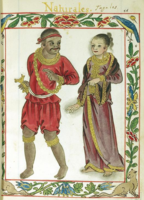
Tagalog royal fashion (1590)
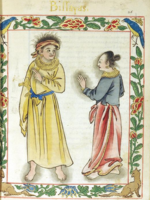
Visayan royal fashion (1590)

Fashion in the Cagayn Valley (1590)
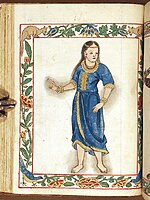
Visayan Binukot fashion (1590)
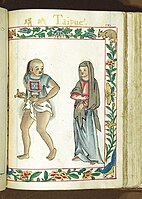
Pangasinense or Ilocano fashion (1590)

Contemporary fashion

Contemporary fashion

Contemporary fashion
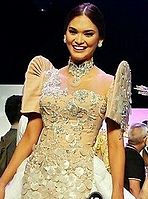
Contemporary fashion
Conservation of the Filipino arts[]
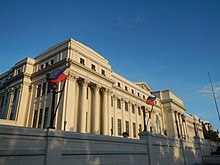

Museums are important vessels for the protection and conservation of Philippine arts. A number of museums in the Philippines possess works of art that have been declared as National Treasures, notably the National Museum of the Philippines in Manila. Other notable museums include Ayala Museum, Negros Museum, Museo Sugbo, Lopez Museum, and Metropolitan Museum of Manila. University museums also hold a vast array of art.[296] Libraries and archives are also important, among the most known are the National Library of the Philippines and the National Archives of the Philippines.[297] Various organizations, groups, and universities have also conserved the arts, especially the performing and craft arts.[297]
Many conservation measures have been undertaken by both private and public institutions and organizations in the country, in addressing the heritage management in the Philippines. The enactment of laws such as the National Cultural Heritage Act have aided in Filipino art conservation. The act also established the country's repository of all culturally-related heritage, the Philippine Registry of Cultural Property.[298] The National Commission for Culture and the Arts is currently the official cultural arm of the Philippine government.[299] There have been proposals to establish a Philippine Department of Culture.[300][301]
See also[]
- Architecture of the Philippines
- Baroque Churches of the Philippines
- Earthquake Baroque
- Cinema of the Philippines
- Philippine comics
- Filipino cartoon and animation
- Literature of the Philippines
- Music of the Philippines
- Filipino martial arts
- Culture of the Philippines
- National Artist of the Philippines
- List of Filipino painters
- National Living Treasures Award (Philippines)
- Pitoy Moreno
References[]
- ^ Jump up to: a b c d e "National Living Treasures Guidelines – National Commission for Culture and the Arts". Ncca.gov.ph. May 5, 2015. Retrieved October 1, 2019.
- ^ Jump up to: a b c "Archived copy" (PDF). Archived from the original (PDF) on July 29, 2018. Retrieved June 9, 2018.CS1 maint: archived copy as title (link)
- ^ Pag-iwayan, J. (2020). Albularyo, babaylan, and manghihilot are now considered national living treasures. Manila Bulletin.
- ^ Pag-iwayan, J. (2020). Albularyo, babaylan, and manghihilot are now considered national living treasures. Manila Bulletin.
- ^ Jump up to: a b William Henry Scott (1994). Barangay: Sixteenth Century Philippine Culture and Society. Quezon City: Ateneo de Manila University Press. ISBN 9715501354.
- ^ A. L. Kroeber (1918). "The History of Philippine Civilization as Reflected in Religious Nomenclature". Anthropological Papers of the American Museum of Natural History. XXI (Part II): 35–37.
- ^ Fay-Cooper Cole & Albert Gale (1922). "The Tinguian; Social, Religious, and Economic life of a Philippine tribe". Field Museum of Natural History: Anthropological Series. 14 (2): 235–493.
- ^ The Tingyans of Northern Philippines and Their Spirit World, Dominic T. Gaioni, Anthropos Bd. 80, H. 4./6. (1985), pp. 381-401
- ^ "A look at Philippine mosques". ncca.gov.ph. Retrieved July 25, 2020.
- ^ Centre, UNESCO World Heritage. "Historic City of Vigan". UNESCO World Heritage Centre.
- ^ Architecture in the Philippines: Filipino building in a cross-cultural context, WW Klassen - 1986 - University of San Carlos
- ^ Heritage Architecture of Batanes Islands in the Philippines: A Survey of Different House Types and Their Evolution, AJF Ignacio - 2008
- ^ Perez III, R.D., R. S. Encarnacion, J. E. Dacanay (with photos by J.R, Fortin and J. K. Chua). 1989. Folk Architecture. Quezon City: GFC Books.
- ^ Centre, UNESCO World Heritage. "Rice Terraces of the Philippine Cordilleras". UNESCO World Heritage Centre.
- ^ "Malay ancestors' 'balangay' declared PH's National Boat | mb.com.ph | Philippine News". December 8, 2015. Archived from the original on December 8, 2015.
- ^ Commercial Fisheries Review. 30. US Bureau of Commericial [sic] Fisheries. July 1968. p. 96.
- ^ Roxas-Lim, Aurora. Traditional Boatbuilding and Philippine Maritime Culture (PDF). International Information and Networking Centre for Intangible Cultural Heritage in the Asia-Pacific Region under the auspices of UNESCO (ICHCAP). pp. 219–222.
- ^ Jump up to: a b c d e f "Traditional Boats in Batanes". International Information and Networking Centre for Intangible Cultural Heritage in the Asia-Pacific Region (ICHCAP). UNESCO. Retrieved October 29, 2019.
- ^ Madale, Abdullah T. (1997). The Maranaws, Dwellers of the Lake. Rex Bookstore, Inc. p. 82. ISBN 9789712321740.
- ^ Lozano, José Honorato (1847). Vistas de las islas Filipinas y trajes de sus habitantes.
- ^ Abrera, Maria Bernadette L. (2005). "Bangka, Kaluluwa at Katutubong Paniniwala (The Soul Boat and the Boat-Soul: An Inquiry into the Indigenous "Soul")" (PDF). Philippine Social Sciences Review. 57 (1–4): 1–15.
- ^ Jump up to: a b c d e f Nimmo, H. Arlo (1990). "The Boats of the Tawi-Tawi Bajau, Sulu Archipelago, Philippines" (PDF). Asian Perspectives. 29 (1): 51–88. S2CID 31792662. Archived from the original (PDF) on November 15, 2019.
- ^ Gunzo Kawamura & Teodora Bagarinao (1980). "Fishing Methods and Gears in Panay Island, Philippines". Memoirs of Faculty of Fisheries Kagoshima University. 29: 81–121.
- ^ "Bigiw-Bugsay: Upholding traditional sailing". BusinessMirror. May 6, 2018. Retrieved July 30, 2019.
- ^ Ricardo E. Galang (1941). "Types of Watercraft in the Philippines". The Philippine Journal of Science. 75 (3): 291–306.
- ^ James Francis Warren (1985). "The Prahus of the Sulu Zone" (PDF). Brunei Museum Journal. 6: 42–45.
- ^ E. T Roe; Le Roy Hooker; Thomas W. Handford, eds. (1907). The New American Encyclopedic Dictionary. J.A. Hill & Company. p. 484.
- ^ Banagudos, Rey-Luis (December 26, 2018). "Wooden boatmaking embraces Mindanao life, culture". Philippine News Agency. Retrieved January 11, 2020.
- ^ Bartolomé Leonardo de Argensola (1711). "The Discovery and Conquest of the Molucco and Philippine Islands.". In John Stevens (ed.). A New Collection of Voyages and Travels, into several Parts of the World, none of them ever before Printed in English. p. 61.
- ^ Yule, Henry & Burnell, Arthur Coke (1886). Hobson-Jobson: Being a Glossary of Anglo-Indian Colloquial Words and Phrases and of Kindred Terms Etymological, Historical, Geographical and Discursive. John Murray. p. 509.CS1 maint: multiple names: authors list (link)
- ^ Maria Bernadette L. Abrera (2007). "The Soul Boat and the Boat-Soul: An Inquiry into the Indigenous "Soul"" (PDF). Philippine Social Sciences Review.[permanent dead link]
- ^ Lim, Frinston (November 25, 2016). "Sa marilag na Lake Sebu hitik ang kalikasan, kultura, adventure". Inquirer Libre Davao. Retrieved July 23, 2019.
- ^ "Palawan by Paraw Boat". Travel+Leisure. Archived from the original on December 5, 2018. Retrieved December 5, 2018.
- ^ Warren, J.F. The Sulu Zone, 1768-1898. Singapore: The Singapore University Press.
- ^ Deveza, JB R. (February 21, 2010). "National pride sails in ancient boats". Philippine Daily Inquirer. Retrieved January 11, 2020.
- ^ Doran, Edwin, Jr., Texas A&M University (1972). "Wa, Vinta, and Trimaran". Journal of the Polynesian Society. 81 (2): 144–159.
- ^ "Forgotten history? The polistas of the Galleon Trade". Rappler.
- ^ "Patterns of culture" (PDF). www.unesco-ichcap.org. Retrieved July 24, 2020.
- ^ "Weaving" (PDF). www.unesco-ichcap.org. Retrieved July 24, 2020.
- ^ IV, Franz Sorilla (May 10, 2017). "Weaving the Threads of Filipino Heritage". Tatler Philippines.
- ^ Ocampo, Ambeth R. (October 19, 2011). "History and design in Death Blankets". Philippine Daily Inquirer.
- ^ Rara: Art and Tradition of Mat Weaving in the Philippines, The Philippine Textile Council, Philippines, 2016, ISBN 978-971-95353-0-4, OCLC 982066949
- ^ "Materials, Functions and Weaving Patterns of Philippine Indigenous Baskets" (PDF). pdfs.semanticscholar.org. 2018. S2CID 134904548. Archived from the original (PDF) on February 12, 2020. Retrieved July 25, 2020.
- ^ "Yuvuk" (PDF). www.unesco-ichcap.org. Retrieved July 25, 2020.
- ^ "Thanks to these Filipino women, basket weaving is revolutionising entire communities". Topics.
- ^ Jump up to: a b "Salakkot and other headgear" (PDF). www.unesco-ichcap.org. Retrieved July 25, 2020.
- ^ "Bubo and other fish traps" (PDF). www.unesco-ichcap.org. Retrieved July 25, 2020.
- ^ "Saked brrom-making" (PDF). www.unesco-ichcap.org. Retrieved July 25, 2020.
- ^ Handicrafts and Folkcrafts Industries in the Philippines: Their Socio-Cultural and Economic Context OV Caparas, VML Lim, NS Vargas - SPAFA Journal, 1992
- ^ Indigenous knowledge and practices for the sustainable management of Ifugao forests in Cordillera, Philippines, LD Camacho, DT Gevaña, AP Carandang, Journal of Biodiversity, 2016
- ^ "Butuan". www.nationalmuseum.gov.ph. Retrieved July 25, 2020.
- ^ The Legal Pluralism Phenomenon: Emerging Issues on Protecting and Preserving the Sacred Ifugao Bulul, M Buenafe - 2011
- ^ The Ifugao Wooden Idol, MM Dancel - SPAFA Digest (1980-1990), 1989
- ^ The Christianization of Davao Oriental: Excerpts from Jesuit Missionary Letters, Jose S. Arcilla, Philippine Studies, Vol. 19, No. 4 (October 1971), pp. 639-724
- ^ Southwestern Philippine Art, JT Peralta - SPAFA Digest (1980-1990), 1982
- ^ Okir: the epiphany of Philippine graphic art, LV Benesa - 1982 - Interlino Print. Company
- ^ Persisting Traditions of Folk Arts and Handicrafts in the Philippines, AC Barbosa - SPAFA Journal (Old series 1991-2013), 1991
- ^ Ang Kosmolohiya at Simbolismo ng mga Sandatang Pilipino: Isang Panimulang Pag-Aaral, L Lasco - DALUMAT E-Journal, 2011
- ^ Jump up to: a b Baraoidan, Kimmy (April 28, 2019). "Wood carving art alive in Paete". Philippine Daily Inquirer.
- ^ Indigenous art at the Philippine Exposition of 1887: Arguments for an ideological and racial battle in a colonial context, LÁ Sánchez Gómez - Journal of the History of Collections, 2002
- ^ Wood Connections: Creating Spaces and Possibilities for Wood Carvers in the Philippines, CD Habito, AV Mariano, 2014
- ^ "Annual report" (PDF). www.nationalmuseum.gov.ph. 2010. Retrieved July 25, 2020.
- ^ [1][dead link]
- ^ Junker, Laura Lee (July 24, 1999). Raiding, Trading, and Feasting: The Political Economy of Philippine Chiefdoms. University of Hawaii Press. ISBN 9780824820350 – via Google Books.
- ^ "Remains of 1,000-year old village unearthed in Philippines". nydailynews.com.
- ^ Baradas, David B. (1968). "Some Implications of the Okir Motif in Lanao and Sulu Art" (PDF). Asian Studies. 6 (2): 129–168. S2CID 27892222. Archived from the original (PDF) on January 29, 2019.
- ^ "Kabayan Mummy Burial Caves - UNESCO World Heritage Centre". whc.unesco.org.
- ^ "Romblon: The country's marble capital is also an island haven". GMA News.
- ^ Paradise in Stone: Representations of New World Plants and Animals on Spanish Colonial Churches in the Philippines, RAG Reyes - Art, Trade, and Cultural Mediation in Asia, 1600–1950, 2019
- ^ Jump up to: a b Centre, UNESCO World Heritage. "Baroque Churches of the Philippines". UNESCO World Heritage Centre.
- ^ "Colletions Seal" (PDF). www.nationalmuseum.gov.ph. Retrieved July 25, 2020.
- ^ Jump up to: a b "Rebultong Garing: Religious Images in Ivory - Intramuros Administration". Google Arts & Culture.
- ^ "The importance of ivory in Philippine culture". www.researchgate.net. Retrieved July 25, 2020.
- ^ "In Global First, Philippines to Destroy Its Ivory Stock". National Geographic News. June 19, 2013.
- ^ Madale, Abdullah T. (July 24, 1997). The Maranaws, Dwellers of the Lake. Rex Bookstore, Inc. ISBN 9789712321740 – via Google Books.
- ^ The folk performing arts in ASEAN, N Duangwises, LD Skar - 2016
- ^ Jump up to: a b "Philippine Dances Cordillera". Seasite.niu.edu. Archived from the original on August 5, 2013. Retrieved August 1, 2013.
- ^ Jump up to: a b "Muslim Mindanao dances". www.seasite.niu.edu.
- ^ Jump up to: a b Philippine Folk Dances: A story of a nation, Monica F.A. W. Santos, University of the Philippines Diliman
- ^ Jump up to: a b The Encyclopedia of World Folk Dance, Mary Ellen Snodgrass
- ^ Jump up to: a b CCP Encyclopedia of Philippine Art: Philippine dance, 1994, Cultural Center of the Philippines
- ^ Jump up to: a b "Hot Spots Filipino Cultural Dance – Singkil". Sinfonia.or.jp. Archived from the original on April 29, 2007. Retrieved February 22, 2015.
- ^ "Filipino epic 'Labaw Donggon' comes to life". ph.news.yahoo.com.
- ^ "PHOTOS: Tanghalang Pilipino's 'Ibalong'". Rappler.
- ^ THE EMERGENCE OF MODERN DRAMA IN THE PHILIPPINES (1898-1912).(Philippine Studies Working Paper No. 1), DG Fernandez - 1977
- ^ Classical Forms of Theater in Asia, NC Rogers - 2005 - University of Santo Tomas
- ^ Jump up to: a b de Noceda, Juan; Pedro de San Lucar (1754). Vocabulario de la lengua tagala, trabaxado por varios sugetos doctos y graves. Manila: Imprenta de la Compañía de Jesús. pp. 324, 440.
- ^ González, N.V.M. (2008). Mindoro and Beyond: Twenty-one Stories. UP Press. p. 243. ISBN 9789715425674. Retrieved August 10, 2016 – via Google Books.
- ^ Smyth, David (2000). The Canon in Southeast Asian Literatures. Psychology Press. p. 52. ISBN 9780700710904. Retrieved August 10, 2016 – via Google Books.
- ^ Pazzibugan, Dona. "'Pabasa' is for meditating, not loud wailing". Philippine Daily Inquirer. Archived from the original on November 18, 2011. Retrieved June 30, 2011.
- ^ Herbert, Patricia (1989). South-East Asia: Languages and Literatures: a Select Guide. University of Hawaii Press. p. 160. ISBN 9780824812676. Retrieved August 10, 2016 – via Google Books.
- ^ Castro, Christi-Anne (May 5, 2011). Musical Renderings of the Philippine Nation. Oxford University Press. p. 32. ISBN 9780199876846.
- ^ Postma, Antoon (1981). "Introduction to ambahan". Treasure of a Minority. Arnoldus Press. Retrieved October 23, 2017.
- ^ De Leon, Mylah (August 24, 2013). "The timeless art of Balagtasan". Moonlighting. Retrieved September 28, 2015.
- ^ Philippine History Module-based Learning I' 2002 Ed. Rex Bookstore, Inc. p. 124. ISBN 9789712334498. Retrieved September 1, 2017.
- ^ Par, Sabrina (May 19, 2015). "Mga tula at awit" [Poems and songs]. SlideShare. University of the Philippines Integrated School. Retrieved December 25, 2016.
- ^ John D. Blanco (February 24, 2009). Frontier Constitutions: Christianity and Colonial Empire in the Nineteenth-Century Philippines. University of California Press. pp. 60–. ISBN 978-0-520-94369-8.
- ^ Escueta, Carla Michaela. "Darangen, The Maranao Epic". ICH Courier Online. International Information and Networking Centre for Intangible Cultural Heritage in the Asia-Pacific Region under the auspices of UNESCO (ICHCAP). Retrieved November 27, 2019.
- ^ Felix Laureano,Recuerdos de Filipinas, Barcelona: 1795, A. Lóopez Robert, impresor, Calle Conde de Asalto (currently called "Carrer Nou de la Rambla"), 63, p. 106.
- ^ Eugenio, Damiana L. (2001). Philippine folk literature. The epics. University of the Philippines Press. ISBN 9789715422949.
- ^ Martinez, PhD, Liza (December 1, 2012). "Primer on Filipino Sign Language". Philippine Daily Inquirer. Retrieved February 9, 2017.
- ^ Outline of Philippine mythology, FL Jocano - 1969 - Centro Escolar University
- ^ "The Aswang Project is working on a Philippine Mythology reference book". April 5, 2019.
- ^ "Philippine Paleographs (Hanunoo, Buid, Tagbanua and Pala'wan) – United Nations Educational, Scientific and Cultural Organization". www.unesco.org.
- ^ "'Educate first': Filipinos react to Baybayin as national writing system". Rappler.
- ^ "House panel approves Baybayin as national writing system". SunStar. April 24, 2018.
- ^ "5 things to know about PH's pre-Hispanic writing system". ABS-CBN News.
- ^ Estudio de los antiguos alfabetos Filipinos (1895), Cipriano Marcilla y Martín, Tipo-litografia del asilo de huérfanos
- ^ "Baybayin Styles & Their Sources". paulmorrow.ca.
- ^ "A primer on Baybayin". GMA News.
- ^ "The Baybayin bill and the never ending search for 'Filipino-ness'". CNN Philippines.
- ^ says, Jessica (August 12, 2015). "10 Perfectly Awesome Calligraphers You Need To Check Out". Bride and Breakfast.
- ^ "WATCH: How to ace in script lettering". The Philippine Star.
- ^ Surat Sug:: Jawi tradition in Southern Philippines, CA Abubakar, 2013
- ^ The poem of Bidasari in the Maranao language, M Julian - Bijdragen tot de Taal-, Land-en Volkenkunde, 2001
- ^ "The revival of Baybayin – an ancient Philippines script ripped up by colonisation". The National.
- ^ "Beyond ABCs: Ancient Philippine script revival kicks up debate". gulfnews.com.
- ^ "World Braille Usage". www.pharmabraille.com. Archived from the original on September 8, 2014. Retrieved July 25, 2020.
- ^ "The Angono-Binangonan Petroglyphs". Artes de las Islas Filipinas. Retrieved September 3, 2014.
- ^ Centre, UNESCO World Heritage. "Petroglyphs and Petrographs of the Philippines". UNESCO World Heritage Centre.
- ^ "IN PHOTOS: Officials call for protection, preservation of newly discovered cave art in Monreal, Masbate". GMA News.
- ^ Jump up to: a b c "The Ceramic Age". ncca.gov.ph. Retrieved July 25, 2020.
- ^ [2]
- ^ Filipino tattoos: Ancient to modern L Wilcken - 2010 - Schiffer Publishing
- ^ An Ethnography of Pantaron Manobo Tattooing (Pangotoeb): Towards a Heuristic Schema in Understanding Manobo Indigenous Tattoos, AMM Ragragio, MD Paluga - Southeast Asian Studies, 2019
- ^ The fading batek: problematizing the decline of traditional tattoos in the Philippine Cordillera Region, FPA Demeterio III - The Journal of the South East Asia Research, 2017
- ^ Blair, Emma Helen (August 25, 2004). The Philippine Islands (EBook #13280 ed.). The Project Gutenberg EBook of The Philippine Islands, 1493-1803, Volume II, 1521-1569, by Emma Helen Blair. p. 126, Volume II.
- ^ G. Nye Steiger, H. Otley Beyer, Conrado Benitez, A History of the Orient, Oxford: 1929, Ginn and Company, pp. 143-144.
- ^ John Kingsley Pangan, Church of the Far East (Makati: St. Pauls), 9.
- ^ THE MANÓBOS OF MINDANÁO by JOHN M. GARVAN United States Government Printing Office Washington : 1931
- ^ Pang-o-tub: The tattooing tradition of the Manobo, 2012
- ^ Talavera, Manalo, Baybay, Saludario, Dizon, Mauro, Porquerino, Novela, Yakit, Banares, Francisco, Inocencio, Rongavilla, Cruz (2013). The T'boli: Songs, Stories and Society. University of the Philippines.
- ^ Redfern, Corinne (April 19, 2018). "Whang-Od: The Last Tattoo Artist". Tatler Philippines.
- ^ Malanes, Maurice (September 10, 2013). "Skin as archive of history, culture, identity". Philippine Daily Inquirer.
- ^ "Reviving Filipino tribal tattoo art". May 27, 2014 – via www.bbc.com.
- ^ Cultural Beliefs and Practices of Ethnic Filipinos: An Ethnographic Study, EJ Grey - Social Sciences, 2016
- ^ Looking Through the Glass: Analysis of Glass Vessel Shards from Pinagbayanan Site, San Juan, Batangas, Philippines, MS Cruz - Hukay, 2014
- ^ Perez, Leila Bernice. "A Glass of its own". The Philippine Star.
- ^ "Dissecting the stained glass windows at the Manila Cathedral". BluPrint. October 11, 2018.
- ^ "Ramon Orlina: A treasured Philippine artist". The Manila Times.
- ^ "Teofilo Garcia". ncca.gov.ph. Retrieved July 25, 2020.
- ^ "The Filipino And The Salacot | Tagalog Dictionary". Tagalog English Dictionary.
- ^ "Morion head mask" (PDF). www.unesco-ichcap.org. Retrieved July 25, 2020.
- ^ "Bacolod's 40th MassKara Festival to open Oct. 7". Philippine News Agency.
- ^ [3]
- ^ "The Angono's Higantes Festival for San Clemente". International Information and Networking Centre for Intangible Cultural Heritage in the Asia-Pacific Region. November 17, 2017. Retrieved July 9, 2020.
- ^ [4][dead link]
- ^ "Kalinga". ncca.gov.ph. Retrieved July 25, 2020.
- ^ Indigenous garments and accessories of the g'addang in barangay ngileb: documentation on production, A Garra - Journal Sampurasun, 2016
- ^ Zafra, Jessica (April 26, 2008). "Art Exhibit: Philippines' 'Gold of Ancestors'". Newsweek. Archived from the original on January 1, 2018. Retrieved December 27, 2017.
- ^ Jump up to: a b "National Museum Collections: Ling-ling O". Official Website National Museum of the Philippines (Beta Website). Archived from the original on November 11, 2011. Retrieved December 27, 2017.
- ^ Jump up to: a b "Philippine Shell Indistry" (PDF). oneocean.org. Retrieved July 25, 2020.f
- ^ Jump up to: a b c "Philippine Gold: Treasures of Forgotten Kingdoms". Asia Society.
- ^ Johnson, Ken (September 24, 2015). "Review: 'Philippine Gold: Treasures of Forgotten Kingdoms'" – via NYTimes.com.
- ^ Sablad, Jo Ann (August 21, 2018). "The crafts of Maranaos". SunStar.
- ^ "National Living Treasures: Eduardo Mutuc". ncca.gov.ph. Retrieved July 25, 2020.
- ^ "De La Salle University". November 20, 2012. Archived from the original on November 20, 2012.
- ^ "Collections". www.nationalmuseum.gov.ph. Retrieved July 25, 2020.
- ^ "Pots". www.nationalmuseum.gov.ph. Retrieved July 25, 2020.
- ^ Ocampo, Ambeth R. (September 13, 2012). "More on the mysterious Luzon jars". Philippine Daily Inquirer.
- ^ Ouano-Savellon, R. (2014). Philippine Quarterly of Culture and Society Vol. 42, No. 3/4: Aginid Bayok Sa Atong Tawarik: Archaic Cebuano and Historicity in a Folk Narrative. University of San Carlos Publications.
- ^ DE AYALA, FERNANDO ZOBEL (1961). "The First Philippine Porcelain". Philippine Studies. 9 (1): 17–19. JSTOR 42719652 – via JSTOR.
- ^ Reyes, Raquel A. G. (2008). Love, Passion and Patriotism: Sexuality and the Philippine Propaganda Movement, 1882 - 1892. NUS Press, National University of Singapore (2008). ISBN 9789971693565. Retrieved November 24, 2013.
- ^ "Mothers". www.nationalmuseum.gov.ph. Retrieved July 25, 2020.
- ^ "5 Places to Get Good Pottery in the Philippines". November 9, 2019.
- ^ "7 local places to shop for ceramic tableware". CNN Philippines.
- ^ Handbook of the Collection of Musical Instruments in the United States National Museum, Bulletin, Issues 136-138, by Frances Densmore
- ^ "City of Crafts and Folk Arts". The Manila Times.
- ^ "'Biggest bell in Asia' found in Capiz town". GMA News.
- ^ Ocampo, Ambeth R. (June 26, 2019). "The Gold Tara of Agusan". Philippine Daily Inquirer.
- ^ "Kampilan". Malay World Edged Weapons. Retrieved February 5, 2009.
- ^ Lawrence, Marc (2009). "Filipino Weapons from A to Z" (PDF). Filipino Martial Arts Digest. Stephen K. Dowd. Archived from the original (PDF) on August 24, 2014. Retrieved July 6, 2020.
- ^ Ramirez y Giraudier (1867). "Diccionario español-ibanag o sea Tesauro Hispano- Cagayán sacado de los manuscritos antiguos". p. 223.
- ^ Filipino martial culture, MV Wiley - 2011
- ^ Filipino Martial Arts: Cabales Serrada Escrima, MV Wiley - 1994
- ^ Eskrima: Filipino martial art, K Godhania - 2012
- ^ Posts Tagged 'master' A Graceffo, MA Odyssey
- ^ "FMA Informative Newspaper" (PDF). www.fmainformative.info. 2016. Retrieved July 25, 2020.
- ^ silat: The curriculum of Seni silat Malaysia, MNM Shapie, MS Elias - Revista de Artes Marciales Asiáticas, 2016
- ^ unlisted (April 28, 2019). "Jendo applies for POC membership". philstar.com. Retrieved July 25, 2020.
- ^ Alejandro, Reynaldo (1985). The Philippine cookbook. New York, New York: Penguin. pp. 12–14. ISBN 978-0-399-51144-8. Archived from the original on June 21, 2013. Retrieved June 30, 2011.
Civitello, Linda (2011). Cuisine and Culture: A History of cavalo and People. John Wiley and Sons. p. 263. ISBN 978-1-118-09875-2. Archived from the original on June 21, 2013. Retrieved June 30, 2011.Just as Filipino people are part Malay, Chinese and Spanish, so is the cuisine of their seven-thousand-island nation
Philippines Country Study Guide. Int'l Business Publications. 2007. p. 111. ISBN 978-1-4330-3970-6. Archived from the original on June 20, 2013. Retrieved June 30, 2011.Throughout the centuries, the islands have incorporated the cuisine of the early Malay settlers, Arab and Chinese traders, and Spanish and American colonizers along with other Oriental and Occidental accent and flavors.
"Philippine Cuisine." Archived June 16, 2011, at the Wayback Machine Balitapinoy.net Archived July 23, 2011, at the Wayback Machine. Accessed July 2011.
Morgolis, Jason (February 6, 2014). "Why is it so hard to find a good Filipino restaurant?". Public Radio International. Archived from the original on December 18, 2014. Retrieved December 17, 2014.Philippine food has Chinese, Malaysian, Spanish and American influences — all cultures that have shaped the Philippines.
- ^ "CNN poll: Philippines has world's 2nd best food". The Philippine Star. June 16, 2015. Archived from the original on October 6, 2016. Retrieved April 7, 2016.
- ^ Tayag, Claude (July 24, 2012). Linamnam: Eating One's Way Around the Philippines. Anvil Pub. ISBN 9789712726408 – via Google Books.
- ^ Orejas, Tonette (November 6, 2019). "12 giant lanterns star in Pampanga's 111-year-old festival". Philippine Daily Inquirer.
- ^ Supermalls, S. M. "Philippines, Belgium kick off int'l pyromusical competition in Clark". ABS-CBN News.
- ^ Potential of virgin coconut oil in the production of lacquer enamel paint, LD dela Cruz, 2010
- ^ The use of non-wood forest products by migrants in a new settlement: experiences of a Visayan community in Palawan, Philippines, C Lacuna-Richman - Journal of ethnobiology and ethnomedicine, 2006
- ^ Later prehistory of the Philippines: colonial images and archaeology, E Bacus - Archaeology International, 1998
- ^ Jump up to: a b c Santos, Tomas U. "Rediscovering traditional arts".
- ^ Mangosing, Frances (November 24, 2019). "Google Doodle celebrates Las Piñas Bamboo Organ 195th anniversary". INQUIRER.net.
- ^ IV, Franz Sorilla (January 30, 2020). "13 Of Metro Manila's Top Florists". Tatler Philippines.
- ^ "Video". www.youtube.com. Retrieved July 25, 2020.
- ^ Grace Nono, Song of the Babaylan: Living Voices, Medicines, Spiritualities of Philippine Ritualist-Oralist-Healers (Quezon City: Institute of Spirituality in Asia, 2013)
- ^ “Balatik: Etnoastronomiya, Kalangitan at Kabihasnang Pilipino”, Dr. Dante L. Ambrosio
- ^ "Gueday stone calendar declared national landmark – The Manila Times". www.manilatimes.net.
- ^ [5]
- ^ "Philippine Hip-hop Dance Scene". philstar.com.
- ^ CONTEMPORARY DANCE IN THE PHILIPPINES, Reynaldo G. Alejandro, Crossroads: An Interdisciplinary Journal of Southeast Asian Studies, Vol. 1, No. 1 (FEBRUARY 1983)
- ^ "A New Generation of Filipino Contemporary Dance Emerges in "Bagong Sayaw" this September 10–18". September 10, 2016.
- ^ Lara, Tanya T. (June 8, 2008). "A little night of music for everyone". The Philippine Star. Retrieved October 17, 2011.
- ^ Olivares, Rick. "Indio I singer is back with his Pinoy reggae fusion". ABS-CBN News.
- ^ "Pinoy rock icons to hold grand gig for Hall of Fame". cnn.
- ^ Herman, Tamar. "Boy Band SB19 Draws Inspiration From K-Pop To Bring Filipino Music To The World". Forbes.
- ^ The Garland handbook of Southeast Asian music. Miller, Terry E.,, Williams, Sean, 1959-. New York. 2008. p. 441. ISBN 9780415960755. OCLC 183147645.CS1 maint: others (link)
- ^ The Maranao Man. Mindanao Art and Culture, Number Four (1980); Marawi City: University Research Center, Mindanao State University; 130pp.
- ^ Cadar, Usopay Hamdag. "Maranao Kolintang Music and Its Journey in America." Asian Music 27(1996): 131-146.
- ^ "More than a Love Song". Himig - The Filipino Music Collection of the Filipinas Heritage Library. Features. Filipinas Heritage Library. Archived from the original on August 8, 2010. Retrieved October 28, 2017.
- ^ "BisRock Band makes noise in Taiwan; hopes to release album soon". INQUIRER.net. July 20, 2019.
- ^ "Music of the Philippines - Filipino Hip-Hop - Encyclopedia II | Global Oneness". Archived from the original on July 28, 2013.
- ^ "Philippines". World Encyclopedia of Puppetry Arts. April 22, 2016. Retrieved July 25, 2020.
- ^ "[PDF] The history of Philippine theatre | Semantic Scholar". S2CID 172130051. Cite journal requires
|journal=(help) - ^ "The Evolution of Philippine Theatre | Solaire Resort & Casino". Solaire.
- ^ "7 Types of Theater in the Philippines". August 24, 2019. Archived from the original on June 25, 2020. Retrieved June 24, 2020.
- ^ Centre, UNESCO World Heritage. "Petroglyphs and Petrographs of the Philippines – UNESCO World Heritage Centre". whc.unesco.org.
- ^ "The Angono-Binangonan Petroglyphs : Philippine Art, Culture and Antiquities". www.artesdelasfilipinas.com.
- ^ Centre, UNESCO World Heritage. "Petroglyphs and Petrographs of the Philippines – UNESCO World Heritage Centre". whc.unesco.org. Archived from the original on December 22, 2019. Retrieved December 26, 2019.
- ^ "The Angono-Binangonan Petroglyphs : Philippine Art, Culture and Antiquities". www.artesdelasfilipinas.com. Archived from the original on April 22, 2018. Retrieved April 19, 2018.
- ^ Jump up to: a b "History Of Philippine Painting". Wiziq.com. Retrieved August 1, 2013.
- ^ Panlilio, Erlinda Enriquez (2003). "Consuming passions: Philippine collectibles", pg. 70. Jaime C. Laya. ISBN 9712714004.
- ^ Jump up to: a b c d "NCCA guidelines" (PDF). ncca.gov.ph. Retrieved February 24, 2020.
- ^ Blanco, John D. (2009). Frontier Constitutions: Christianity and Colonial Empire in the Nineteenth-Century Philippines. University of California. ISBN 978-0-520-25519-7.
- ^ [6]
- ^ Inquirer, Philippine Daily (April 19, 2015). "Philippine history told through art". INQUIRER.net.
- ^ Pinto, Sonia (April 23, 2020). "From the Archives: Anita Magsaysay Ho: Her Life, Art, And Philosophies". Tatler Philippines.
- ^ "DID YOU KNOW: Abdulmari Asia Imao 2nd death anniversary". INQUIRER.net. December 16, 2016.
- ^ "Philippines Fiesta !", beMuse Magazine, Singapore National Heritage Board, 2009
- ^ James M. Henslin, "Essentials of Sociology: A Down to Earth Approach - Sixth Edition", Allyn and Bacon, Needham Heights, MA, 2006
- ^ "Elmer Borlongan, by the book". Inquirer Lifestyle. April 27, 2019.
- ^ "Filipino Artists Unite to Fight New Anti-Terror Bill". www.artforum.com.
- ^ [7]
- ^ "BenCab and 100 more of CCP's 13 Artist awardees issue statement against Anti-Terror Law". ABS-CBN News.
- ^ Sculpture in the Philippines: from Anito to assemblage and other essays, A Guillermo - 1991 - Metropolitan Museum of Manila
- ^ [8][dead link]
- ^ Torrevillas, Domini M. "On Tandang Sora's 203rd birth anniversary". philstar.com.
- ^ "Structures obstructing Lapu-Lapu Shrine to be demolished". www.pna.gov.ph.
- ^ Enriquez, Arch Ken (February 22, 2020). "Monuments and memorials: A vessel of memories". INQUIRER.net.
- ^ See, Aie Balagtas (December 26, 2017). "'Comfort woman' statue not an insult vs Japan'". INQUIRER.net.
- ^ Filipinas. Filipinas Pub. 2003. p. 20.
- ^ The Dynamic Teeners of the 21st Century Ii ' 2005 Ed. Rex Bookstore, Inc. p. 68. ISBN 978-971-23-4046-8.
- ^ "Tirada: Five Decades of Philippine Printmaking". Vera Files.
- ^ Jump up to: a b Guardiola, Juan. The Philippine Imaginary, Sociedad Española de Acción Cultural en el Exterior (SEACEX), Casa Asia and Seacex.es (undated) Archived 2007-09-27 at the Wayback Machine, retrieved on: August 11, 2007
- ^ "Father of Philippine Photography in the spotlight".
- ^ "Ambahan". www.mangyan.org.
- ^ Lessing J. Rosenwald. "Lessing J. Rosenwald Collection". Library of Congress. World Digital Library. Retrieved November 28, 2010.
- ^ The Sources of Gaspar Aquino de Belen's Pasyon, Rene B. Javellana, Philippine Studies,Vol. 32, No. 3 (Third Quarter 1984), pp. 305-321, Aeneo de Manila University
- ^ Manuel, E. Arsenio (1963). "A Survey of Philippine Folk Epics". Asian Folklore Studies. 22: 1–76.
- ^ 1100262L (March 2013). "Florante and Laura". StudyMode. Retrieved March 11, 2014.
- ^ "Philippine Heroes – Francisco Baltazar Balagtas y Dela Cruz (1788–1862)". Etravel Pilipinas. Archived from the original on March 11, 2014. Retrieved March 11, 2014.
- ^ Fernandez, Doreen (1978). The Iloilo Zarzuela, 1903–1930. Quezon City: Ateneo de Manila University Press. Retrieved October 9, 2019.
- ^ Hosillos, Lucila, ed. (1992). Hiligaynon Literature: Texts and Contexts. Quezon City: Aqua-Land Enterprises. p. 74. ISBN 971-636-000-2. Retrieved October 9, 2019.
- ^ Literatura Filipina en Castellano, Madrid, 1974. ISBN 84-276-1205-2
- ^ THE "NATION" IN VICENTE SOTTO'S LITERARY IMAGINATION: A STUDY OF THIRTEEN CEBUANO STORIES, Rosario Cruz-Lucero, Philippine Quarterly of Culture and Society, Vol. 31, No. 4, SPECIAL ISSUE: CEBUANO LITERARY STUDIES (December 2003), pp. 291-306, University of San Carlos Publications
- ^ Santos, Lope K. Banaag at Sikat, Bookmark, Philippines, 1988
- ^ Hawley, John Charles; Nelson, Emmanuel (2001). Encyclopedia of Postcolonial Studies. Westport, CT: Greenwood, Publishing Group. pp. 177. ISBN 0313311927.
- ^ McFerson, Hazel (2002). Mixed Blessing: The Impact of the American Colonial Experience on Politics and Society in the Philippines. Westport, CT: Greenwood Publishing Group. p. 99. ISBN 0313307911.
- ^ "Sa Mga Kuko ng Liwanag". www.goodreads.com.
- ^ Dekada 70 Ang Orihinal at Kumpletong Edisyon at Bookfinder.com Retrieved 18 December 2006.
- ^ "Mga Ibong Mandaragit" by Amado V. Hernandez, from Amado V. Hernandez: A National Artist, shvoong.com
- ^ "Luha ng Buwaya" by Amado V. Hernandez, from Amado V. Hernandez article, aijc.com
- ^ Hidalgo (2006), p. 79.
- ^ Skeletons in the Closets: Gay Themes in Philippine Fictions in English, Christopher Yap Wright, Rupkatha Journal on Interdisciplinary Studies in Humanities 9(2):293-302, 2017
- ^ Mars-Jones, Adam (June 26, 2010). "Ilustrado by Miguel Syjuco | Book review" – via www.theguardian.com.
- ^ Aw, Tash (August 28, 2019). "Insurrecto by Gina Apostol review – struggles in the Philippines". The Guardian.
- ^ "The Role of José Nepomuceno in the Philippine Society: What language did his silent film speaks?". Stockholm University Publications. Retrieved on January 6, 2011.
- ^ "Is the Curtain Finally Falling on the Philippine Movie Industry?". PhilNews.com. Retrieved January 25, 2009.
- ^ Jump up to: a b Anonymous. "History of Philippine Cinema". Philippine Journeys. Retrieved January 22, 2009.
- ^ Ramoran-Malasig, Carol. "Philippine Cinema Is Growing Fast, And Is Moving Away From Typical Themes Of Poverty And Violence". Forbes.
- ^ Lee, Nathan (September 22, 2006). "Floating Above the Slums of Manila on a Current of Love" – via NYTimes.com.
- ^ News, ABS-CBN. "Chito Roño unleashes a different Sharon in 'Caregiver'". ABS-CBN News.
- ^ Villasanta, Boy. "Movie Review: "Kinatay," a dark movie". ABS-CBN News.
- ^ Lodge, Guy (September 7, 2012). "Thy Womb".
- ^ "Antoinette Jadaone and the romantic road to 'That Thing Called Tadhana'". Rappler.
- ^ "Philippines revenge drama wins at Venice". September 11, 2016 – via www.bbc.com.
- ^ "'Smaller and Smaller Circles' review: Deserves to be seen". Rappler.
- ^ Jump up to: a b c Noche, Manual. "History of Philippine Architecture". ncca.gov.ph. Retrieved July 24, 2020.
- ^ Ichimura, Anri (April 10, 2020). "'Earthquake' Baroque Churches in the Philippines". Esquiremag.ph. Retrieved July 24, 2020.
- ^ "Baroque Churches of the Philippines". UNESCO Multimedia Archives. February 22, 1999. Retrieved July 24, 2020.
- ^ ANCX (June 23, 2020). "This book toasts Art Deco style in the PH, from cinemas to cemeteries, in 500+ archival images". ABS-CBN News. Retrieved July 24, 2020.
- ^ Harper, Bambi (April 15, 2020). "OPINION: How Important Is The Preservation And Restoration Of Historic Landmarks In The Philippines?". Tatler Philippines. Retrieved July 24, 2020.
- ^ Interior Design in the Philippines: A Retrospect of Spaces and Culture, Edith Oliveros and Raquel Baltazar-Florendo, 2013,University of Santo Tomas Publishing House
- ^ "Evolution of interior design". Manila Standard. Retrieved July 24, 2020.
- ^ BusinessMirror (February 23, 2020). "Landscape architects shift emphasis to the ecosystem". BusinessMirror. Retrieved July 24, 2020.
- ^ "Philippines Business, Financial And Economic News". Inquirer.net. December 11, 2018. Retrieved July 24, 2020.
- ^ "9 urban planners and architects illustrate their ideal EDSA". cnn. December 11, 2018. Retrieved July 24, 2020.
- ^ Heskett 1980, p. 10.
- ^ Noblet 1993, pp. 21–22.
- ^ Sustainable industrial design and waste management: cradle-to-cradle for sustainable development, S El Haggar - 2010
- ^ Taking the right road to inclusive growth: Industrial upgrading and diversification in the Philippines, N Usui - 2012
- ^ "Design Week Philippines". About CITEM. October 20, 2011. Retrieved July 24, 2020.
- ^ "IN PHOTOS: Where to find 'cherry blossoms' in the Philippines". rappler.com. 2019. Retrieved July 24, 2020.
- ^ Dress, Status, and Identity in the Philippines: Pineapple Fiber Cloth and Ilustrado Fashion, M Roces - Fashion Theory, 2013
- ^ Investigating second-hand fashion trade and consumption in the Philippines: Expanding existing discourses, VL Isla - Journal of Consumer Culture, 2013
- ^ Corp., ABS-CBN (June 30, 2019). "How To Wear Philippine Indigenous Textiles Responsibly, According To A Textile Expert". Metro.Style. Retrieved July 24, 2020.
- ^ "Museums are Important Vessels of History and Culture". Philippine Information Agency.
- ^ Jump up to: a b "Dayaw Features Cultural Filipino Dances and Artists". Loren Legarda. July 22, 2020. Retrieved July 24, 2020.
- ^ "Republic Act No. 10066". The Lawphil Project. December 14, 2009. Retrieved July 24, 2020.
- ^ "Official website". www.ncca.gov.ph. Archived from the original on May 25, 2011. Retrieved July 24, 2020.
- ^ Arayata, Ma. Cristina (February 6, 2019). "NRCP backs creation of Department of Culture". Philippine News Agency. Retrieved July 24, 2020.
- ^ "The Department of Culture inches forward". Philippine Daily Inquirer. March 5, 2020. Retrieved July 24, 2020.
External links[]
| Wikimedia Commons has media related to Art of the Philippines. |
- Arts in the Philippines
- Art by country






























